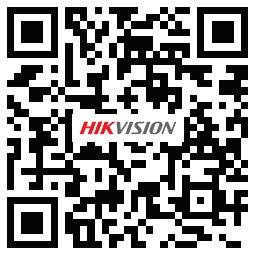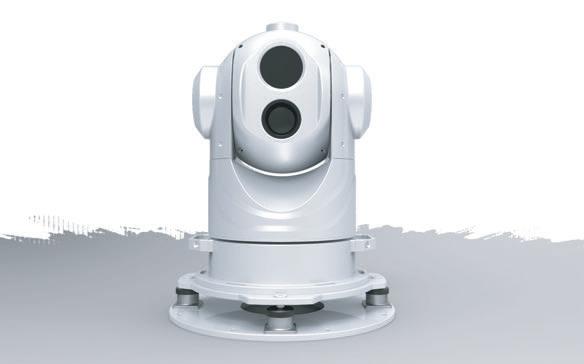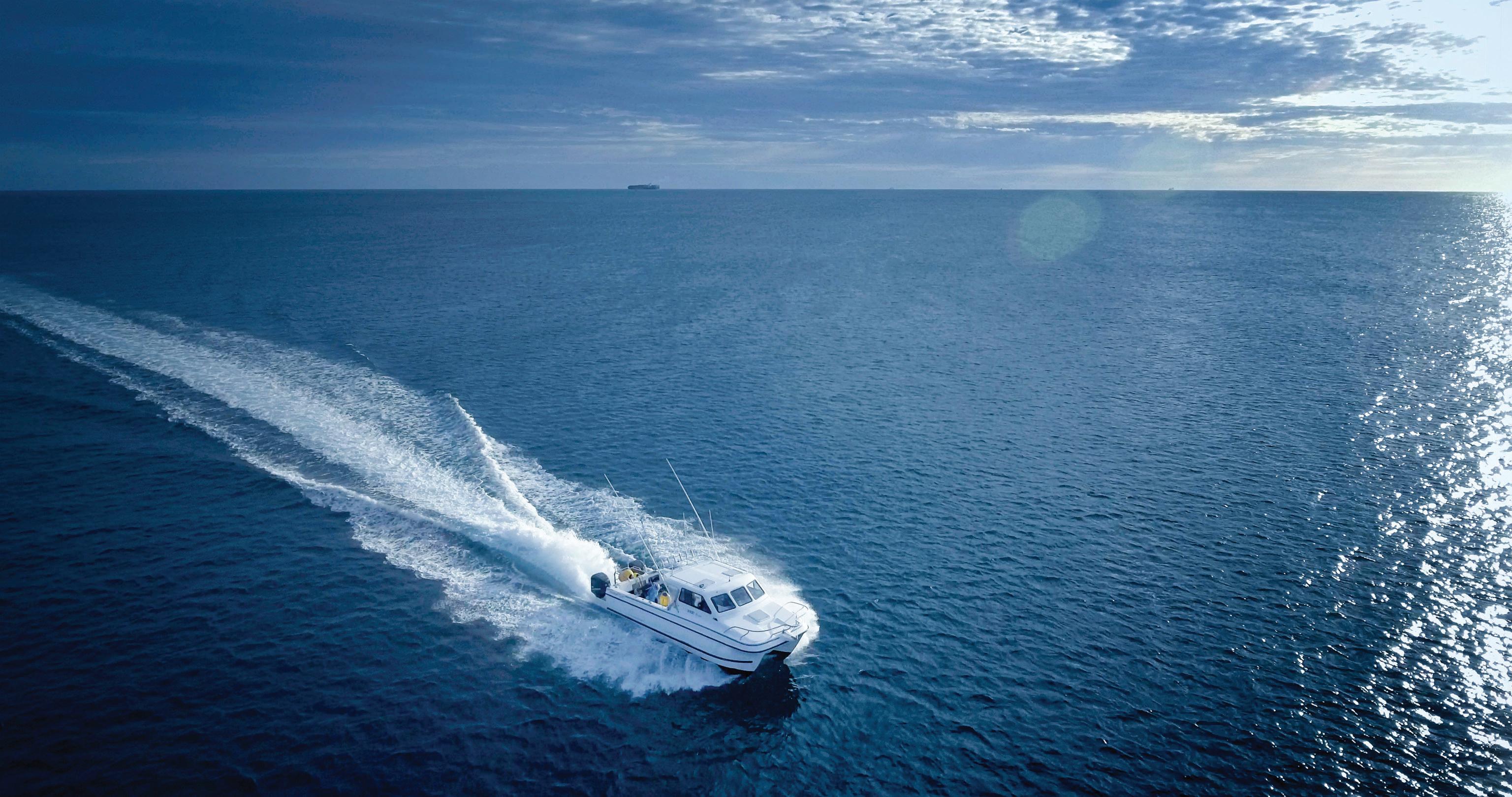






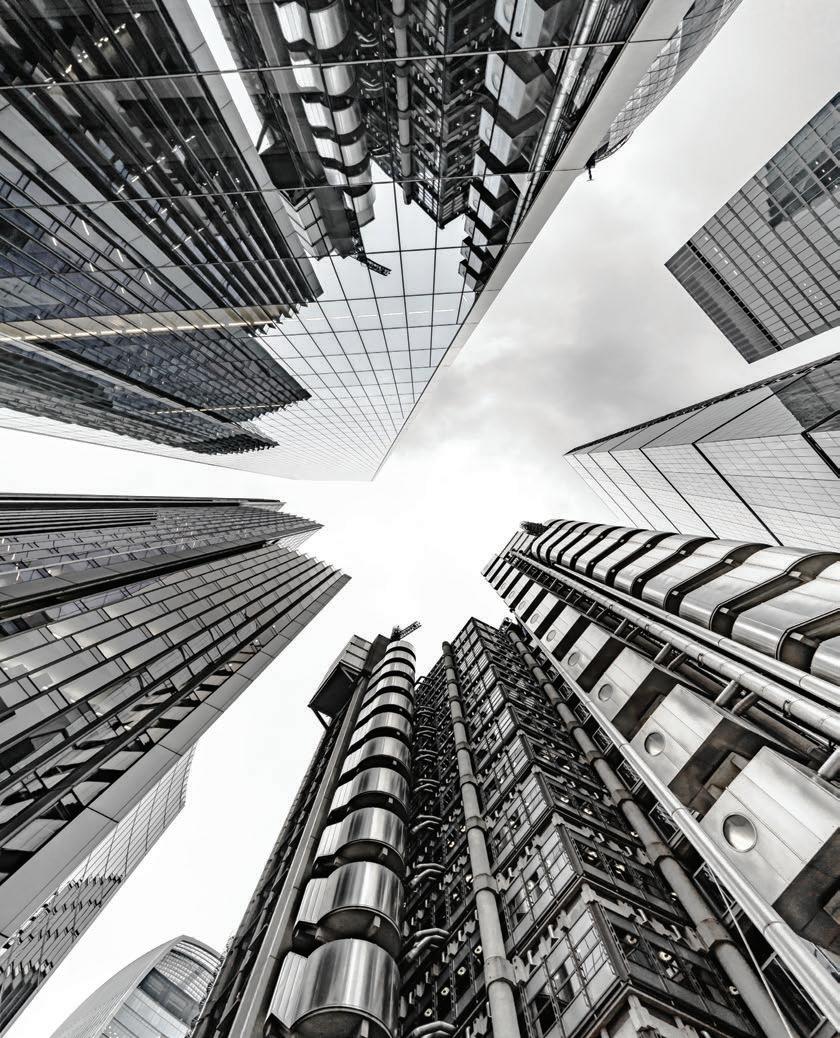
3,200/page RM 3,200/page
Full-Page, Full-Colour Advertisement
This one-time-only special rate o er is for new advertisers.
Space availability is subject to booking on a first-come-first-served basis.
Clients will provide ready-to-print artwork in PDF format with 300dpi.
Full page: 210mm x 285mm, 5mm extra bleed sizes for 4-sided with crop mark.
Advertising space must be utilised before 30 June 2024.
*Please note that the above rate will be subjected to 6% SST. For overseas advertisers, an additional 25% will be charged.
Rate shown above excludes 15% advertising agency commission.
Payment term: Full advance payment.
Artwork submission deadline is on (or before) the 1st week of the prior month of publication. After the material deadline, no cancellation or alteration to the advertisement will be entertained.
Any cancellation after signing the advertising order will result in a 50% penalty charge.
The publisher reserves the right to edit, revise or reject any advertisement deemed unsuitable or inappropriate. •
JURUTERA has an estimated readership of 200,000 professionals. Our esteemed readership consists of certi ed engineers, decision making corporate leaders, CEOs, government o cials, project directors, entrepreneurs, project consultants, engineering consulting rms and companies involved with engineering products and services. Circulation & Readership Pro le
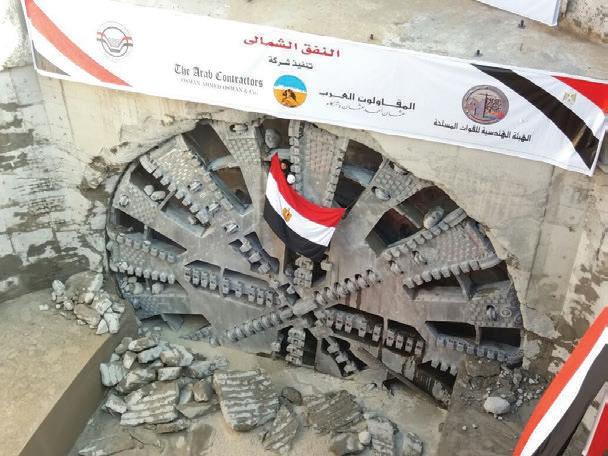
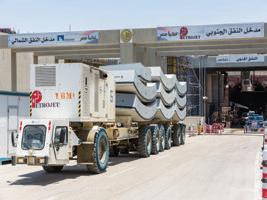
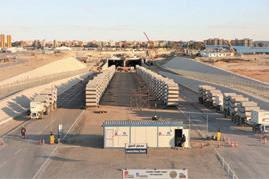

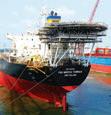
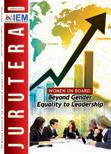

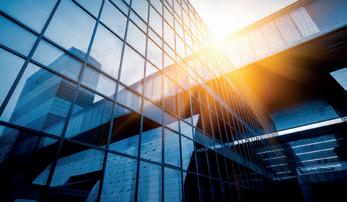





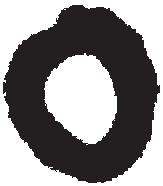



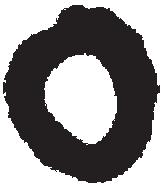




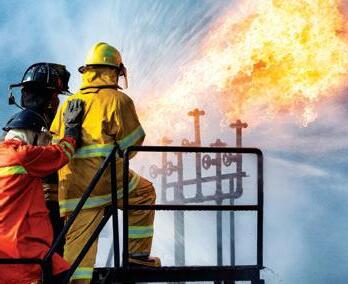
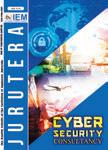

MAJLIS BAGI SESI 2023/2024 (IEM COUNCIL SESSION 2023/2024)
YANG DIPERTUA / PRESIDENT
Ir. Prof. Dr Norlida bt Buniyamin
TIMBALAN YANG DIPERTUA / DEPUTY PRESIDENT
Ir. Prof. Dr Jeffrey Chiang Choong Luin
NAIB YANG DIPERTUA / VICE PRESIDENTS
Ir. Mohd Khir bin Muhammad, Ir. Ts. Prof. Dr Tan Chee Fai, Ir. Abdul Razak bin Yakob,
Ir. Yau Chau Fong, Ir. Dr Siti Hawa binti Hamzah, Ir. Fam Yew Hin, Ir. Chen Harn Shean
SETIAUSAHA KEHORMAT / HONORARY SECRETARY
Ir. Prof. Dr Zuhaina binti Zakaria
BENDAHARI KEHORMAT / HONORARY TREASURER
Ir. Assoc. Prof. Dr David Chuah Joon Huang
BEKAS YANG DIPERTUA TERAKHIR / IMMEDIATE PAST PRESIDENT
Ir. Ong Ching Loon
BEKAS YANG DIPERTUA / PAST PRESIDENTS
Y.Bhg. Academician Tan Sri Datuk Ir. (Dr) Ahmad Zaidee bin Laidin, Y.Bhg. Dato’ Paduka Ir. Hj. (Dr) Keizrul bin Abdullah, Y.Bhg. Tan Sri Dato’ Seri Academician Ir. Professor Emeritus Dr Chuah Hean Teik, Y.Bhg. Dato’ Ir. Lim Chow Hock, Ir. Dr Tan Yean Chin
WAKIL AWAM / CIVIL REPRESENTATIVE
Ir. Tu Yong Eng
WAKIL MEKANIKAL / MECHANICAL REPRESENTATIVE
Ir. Ng Yong Kong
WAKIL ELEKTRIK / ELECTRICAL REPRESENTATIVE
Ir. Mohd. Aman bin Hj. Idris
WAKIL STRUKTUR / STRUCTURAL REPRESENTATIVE
Ir. Dr Tan Kuang Leong
WAKIL KIMIA / CHEMICAL REPRESENTATIVE
Ir. Dr Chong Chien Hwa
WAKIL LAIN-LAIN DISPLIN / REPRESENTATIVE TO OTHER DISCIPLINES
Ir. Assoc. Prof. Dr Wong Yew Hoong
WAKIL MULTIMEDIA DAN ICT / ICT AND MULTIMEDIA REPRESENTATIVE
Ir. Assoc. Prof. Dr Lai Khin Wee
WAKIL JURUTERA WANITA / WOMEN ENGINEERS REPRESENTATIVE
Ir. Noorfaizah binti Hamzah
WAKIL BAHAGIAN JURUTERA SISWAZAH / YOUNG ENGINEERS SECTION REPRESENTATIVES
Mr. Muhammad Ashiq Marecan bin Hamid Marecan, Grad. IEM, Mr. Lim Yiren, Mr. Darshan a/l Balasubramaniam, Grad. IEM, Mr. Ooi Wei Chien, Grad. IEM, Ms. Ong Ye Shian, Grad. IEM AHLI - AHLI MAJLIS / COUNCIL MEMBERS
Ir. Dr Vigna Kumaran a/l Ramachandaramurthy (casual vacancy for Ir. Dr Siti Hawa binti Hamzah for 1 session), Ir. Assoc. Prof. Dr Lee Tin Sin, Ir. Mah Way Sheng, Ir. Sreedaran Raman, Ir. Lee Cheng Pay, Ir. Dr Kannan a/l M. Munisamy, Ir. Dr Siow Chun Lim, Ir. Wong Chee Fui, Ir. Ts. Assoc. Prof. Dr Hum Yan Chai, Ir. Tiong Ngo Pu, Ir. Rusnida binti Talib, Ir. Prof. Dr Lau Hieng Ho, Ir. Dr Muhammad Azmi bin Ayub, Ir. Arul Hisham bin Abdul Rahim (casual vacancy for Ir. Fam Yew Hin - for 2 sessions), Ir. Razmahwata bin Mohd Razalli, Ir. Simon Yeong Chin Chow, Ir. Dr Chan Seong Phun, Ir. Yam Teong Sian, Ir. Kwok Yew Hoe, Ir. Dr Lee Choo Yong, Ir. Sharifah Azlina binti Raja Kamal Pasmah, Ir. Ts. Dr Wan Syakirah binti Wan Abdullah, Ir. Dr Mui Kai Yin, Ir. Shamil bin Abu Hassan, Ir. Wan Rizaluddin Abdullah bin Wan Ali, Ir. Prof. Dr Lam Wei Haur (casual vacancy for Ir. Prof. Dr Zuhaina bt Zakaria for 3 sessions) AHLI - AHLI MAJLIS JEMPUTAN / COUNCIL MEMBERS BY INVITATION
Ir. Lai Sze Ching, Ir. Gopal Narian Kutty, Y.Bhg. Dato’ Prof. Ir. Dr Mohd Hamdi bin Abd Shukor PENGERUSI CAWANGAN / BRANCH CHAIRMAN
1. Pulau Pinang: Ir. Chan Wah Cheong
2. Selatan: Ir. Thayala Rajah s/o Selvaduray
3. Perak: Ir. Assoc. Prof. Dr Nursyarizal bin Mohd Nor 4. Pahang: Ir. Ab Rahman bin Hashim
5. Kedah-Perlis: Ir. Roshasmawi bin Abdul Wahab
6. Negeri Sembilan: Ir. Shahrin Amri bin Jahari
7. Kelantan: Ir. Ts. Hj. Abrizan bin Abdul Kadir
8. Terengganu: Ir. Mazlan bin Che Ku Ahmad
9. Melaka: Ir. Ong Yee Pinn
10. Sarawak: Ir. Sim Hui Kheng, Stephanie
11. Sabah: Ir. Chin Tet Fu, Willy
12. Miri: Ir. Chong Boon Hui
AHLI JAWATANKUASA INFORMASI DAN PENERBITAN/ STANDING COMMITTEE ON INFORMATION AND PUBLICATIONS 2023/2024
Pengerusi/Chairman: Ir. Abdul Razak bin Yakob Naib Pengerusi/Vice Chairman: Ir. Dr Siow Chun Lim Setiausaha/Secretary: Ir. Ts. Assoc. Prof. Dr Hum Yan Chai Ketua Pengarang/Chief Editor: Ir. Abdul Razak bin Yakob Pengarang Prinsipal Buletin/ Principal Bulletin Editor: Ir. Razmahwata bin Mohamad Razalli Pengarang Prinsipal Jurnal/Principal Journal Editor: Ir. Ts. Assoc. Prof. Dr Teo Fang Yenn Pengerusi Aplikasi Mudah Alih IEMGo/IEMGo Mobile Application Chairman: Ir. Dr Bhuvendhraa Rudrusamy Pengerusi Penglibatan Ahli/Members Engagement Chairperson: Ir. Rusnida binti Talib Pengerusi Pusat Sumber/Resource Centre Chairman: Ir. Dr Kannan a/l M. Munisamy
Ahli-Ahli/Committee Members: Ir. Ong Guan Hock, Ir. Lee Chang Quan, Ir. Lau Tai Onn, Ir. Dr Oh Seong Por, Ir. Yee Thien Seng, Ir. Dr Lee Choo Yong, Ir. Ts. Dr Tan Kim Seah, Ir. Assoc. Prof. Dr Lee Tin Sin, Dr Sudharshan N. Raman, Grad. IEM, Ms. Michelle Lau Chui Chui, Grad. IEM, Ir. Tu Yong Eng, Ir. Dr Nor Ilia Anisa binti Aris, Mr. Muhd Ashiq Marecan bin Hamid Marecan, Grad. IEM, Mr. Chuah Pei Lim, Grad. IEM
LEMBAGA PENGARANG/EDITORIAL BOARD 2023/2024
Ketua Pengarang/Chief Editor: Ir. Abdul Razak bin Yakob Pengarang Prinsipal Buletin/ Principal Bulletin Editor: Ir. Razmahwata bin Mohamad Razalli Ahli-ahli/Committee Members: Ir. Dr Siow Chun Lim, Ir. Lau Tai Onn, Ir. Ong Guan Hock, Ir. Yee Thien Seng, Ir. Dr Oh Seong Por, Ir. Ts. Assoc. Prof. Dr Teo Fang Yenn, Dr Sudharshan N. Raman, Ir. Tu Yong Eng, Ir. Lee Chang Quan, Ir. Dr Lee Choo Yong, Ir. Ts. Dr Tan Kim Seah, Ms. Michelle Lau Chui Chui, Grad. IEM Secretariat: Janet Lim, Nurul Aida binti Mustafa, Nur Illyarnie binti Rosman
THE INSTITUTION OF ENGINEERS, MALAYSIA Bangunan Ingenieur, Lots 60 & 62, Jalan 52/4, P.O. Box 223, (Jalan Sultan), 46720 Petaling Jaya, Selangor Darul Ehsan. Tel: 603-7968 4001/4002 Fax: 603-7957 7678 E-mail: sec@iem.org.my Homepage: http://www.myiem.org.my
Underwater Inspection of Port and Jetty Structure
Decarbonising Marine Transportation
Welding Procedure Development Concept (Quality, Safety & Metal 3D Printing Perspective)
Inculcating First-Class Maintenance Culture
Exploring the Depths: A Day at Subsea Rover (SSR) Sdn. Bhd.
Exploring Thailand in Ancient City (Muang Boran)
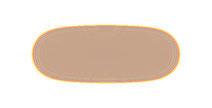
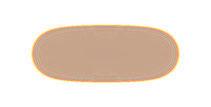


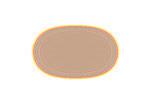








DIMENSION PUBLISHING SDN. BHD. [ 199701034233 (449732-T) ]
Level 18-01, PJX-HM Shah Tower, No. 16A, Persiaran Barat, 46050 Petaling Jaya, Selangor Darul Ehsan, Malaysia.
Tel: +(603) 7493 1049 Fax: +(603) 7493 1047
E-mail: info@dimensionpublishing.com
Website: www.dimensionpublishing.com
CHAIRMAN
ROBERT MEBRUER
CEO/PUBLISHER
PATRICK LEUNG
GENERAL MANAGER
SHIRLEY THAM ● shirley@dimensionpublishing.com
HEAD OF MARKETING & BUSINESS DEVELOPMENT
JOSEPH HOW ● joseph@dimensionpublishing.com
PRODUCTION EDITOR
TAN BEE HONG ● bee@dimensionpublishing.com
CONTRIBUTING WRITERS
PUTRI ZANINA ● putri@dimensionpublishing.com
HANNA SHEIKH MOKHTAR ● hanna@dimensionpublishing.com
SENIOR GRAPHIC DESIGNER
SOFIA HANIS ● sofia@dimensionpublishing.com
GRAPHIC DESIGNER
NICOLE THENG ● nicole@dimensionpublishing.com
ADVERTISING CONSULTANTS
THAM CHOON KIT ● ckit@dimensionpublishing.com
ACCOUNTS CUM ADMIN EXECUTIVE
YEN YIN ● yenyin@dimensionpublishing.com
For advertisement placements and subscriptions, please contact: DIMENSION PUBLISHING SDN. BHD. [ 199701034233 (449732-T) ]
Level 18-01, PJX-HM Shah Tower, No.16A, Persiaran Barat, 46050 Petaling Jaya, Selangor Darul Ehsan, Malaysia.
Tel: +(603) 7493 1049 Fax: +(603) 7493 1047 E-mail: info@dimensionpublishing.com
Subscription Department E-mail: info@dimensionpublishing.com
JURUTERA is published and printed monthly by Dimension Publishing Sdn. Bhd.
JURUTERA MONTHLY CIRCULATION: OVER 50,000 MEMBERS
Submission or placement of articles in JURUTERA could be made to the:Chief Editor
THE INSTITUTION OF ENGINEERS , MALAYSIA (IEM) Bangunan Ingenieur, Lots 60 & 62, Jalan 52/4, P.O. Box 223 (Jalan Sultan), 46720 Petaling Jaya, Selangor. Tel: +(603) 7968 4001/4002 Fax: +(603) 7957 7678 E-mail: pub@iem.org.my or sec@iem.org.my IEM Website: http://www.myiem.org.my
© 2023, The Institution of Engineers, Malaysia (IEM) and Dimension Publishing Sdn. Bhd.
PUBLICATION DISCLAIMER
The publication has been compiled by both IEM and Dimension with great care and they disclaim any duty to investigate any products, process, services, designs and the like which may be described in this publication. The appearance of any information in this publication does not necessarily constitute endorsement by IEM and Dimension. There is no guarantee that the information in this publication is free from errors. IEM and Dimension do not necessarily agree with the statement or the opinion expresssed in this publication.
COPYRIGHT
JURUTERA Bulletin of IEM is the official magazine of The Institution of Engineers, Malaysia (IEM) and is published by Dimension Publishing Sdn. Bhd. The Institution and the Publisher retain the copyright over all materials published in the magazine. No part of this magazine may be reproduced and transmitted in any form or stored in any retrieval system of any nature without the prior written permission of IEM and the Publisher.
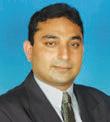
Decarbonising marine transport is an imperative step towards mitigating climate change and reducing the environmental impact of the shipping industry as this sector is responsible for a significant portion of global greenhouse gas emissions, primarily due to the use of fossil fuels in its vessels.
To achieve decarbonisation, various strategies are being pursued. First and foremost is the transition to alternative fuels and propulsion technologies. This includes the adoption of cleaner options such as Liquefied Natural Gas (LNG), biofuels and hydrogen as well as the development of electric and hybrid propulsion systems. Additionally, optimising vessel design and improving operational efficiency can significantly reduce emissions.
International regulations, like the International Maritime Organisation’s (IMO) strategy to reduce greenhouse gas emissions, are pushing the industry to embrace these changes. Carbon pricing mechanisms and incentives for sustainable practices are also being considered.
Collaboration among industry stakeholders, governments and researchers is essential for the successful decarbonisation of marine transport. With innovation, regulation and cooperation, the shipping sector can play a pivotal role in achieving global climate goals while ensuring the continued movement of goods across the oceans.
This month’s JURUTERA features Ts. Hazrool Rizal bin Abdul Rahim, Senior Assistant Director of the Maritime Industry Control Division, Malaysia Marine Department (MMD). Enjoy!
by Ir. Razmahwata bin Mohamad Razalli Principal Bulletin Editor
The IT Department in IEM comprises four staff members who handle everything related to IEM’s computing infrastructure. They also do forward-facing interfaces and processes for members and the public which include the website, social media, balloting and forms.
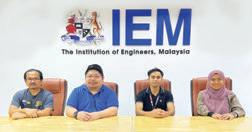
The COVID pandemic forged them into virtual space maestros as this was critical to move IEM quickly into the virtual arena as well as to arrange hybrid meetings and activities. In addition, they have also become a source of income for IEM by outsourcing their expertise in arranging hybrid events with external organisations. “Nos salutant vos” (We salute you).
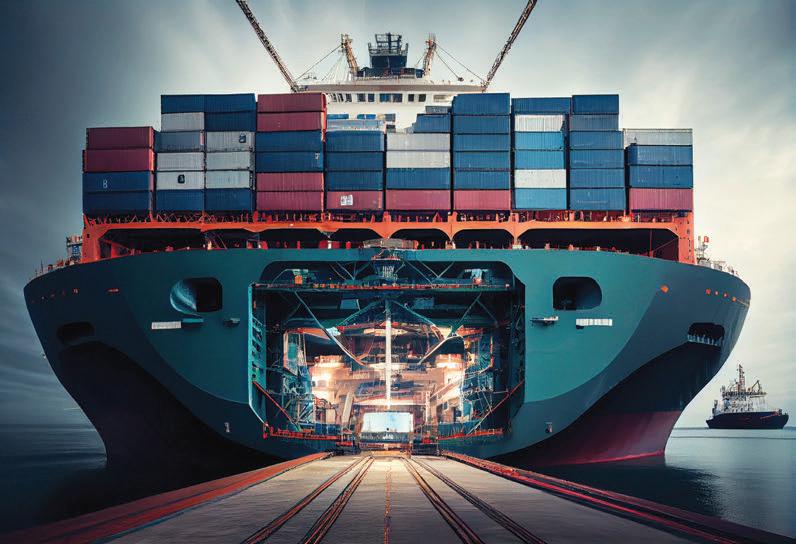
In 2018, the International Maritime Organisation set an ambitious goal to cut greenhouse gas (GHG) emissions in ships by at least 50% by 2050. Ships emit more than one billion tons of GHG or nearly 3% of emissions worldwide, so maritime decarbonisation is critical to decarbonising the global economy as a whole. To do this means steering away from the use of standard petroleum-based fuels such as diesel in favour of LNG and biofuels.
In May 2019, the Norwegian government and the IMO established the Green Voyage 2050 Project to move the industry to a lowercarbon future and Malaysia was accepted as a Pioneer Pilot Country. Ts. Hazrool Rizal bin Abdul Rahim, Senior Assistant Director of the Maritime Industry Control Division, Malaysia Marine Department (MMD), tells JURUTERA that though Malaysia is on the right track in maritime decarbonisation, a lot remains to be done.
Ts. Hazrool Rizal bin Abdul Rahim is Senior Assistant Director at Malaysia Marine Department’s Maritime Industry Control Division. He oversees maritime governance, inspections, issuance of statutory certificates, and ensuring safety compliance. As a frequent representative at IMO conferences, he ensures adherence to international maritime standards. He is a distinguished speaker at various maritime conferences locally and internationally. With a pivotal role in ship assessment, pollution prevention, and service quality, Hazrool is a dedicated professional.

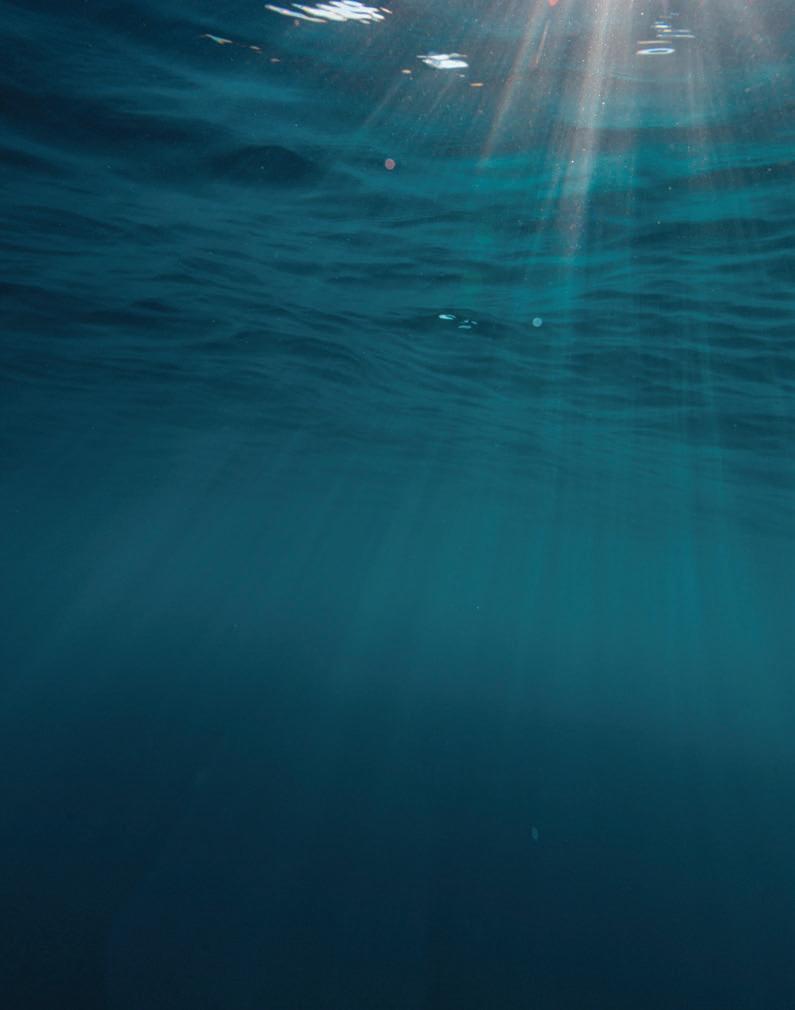
Can you provide an overview of the status of GHG emissions from the marine and shipping industry in Malaysia and the ASEAN region? In 2022, the Malaysia Marine Department (MMD) joined the Green Voyage 2050 (GV2050) Project as a Pioneer Pilot Country. Other participating countries are Azerbaijan, Belize, China, Cook Islands, Ecuador, Georgia, India, Kenya, Malaysia, Solomon Islands, South Africa and Sri Lanka. The project was established in May 2019 as a collaboration between the Norwegian government and the International Maritime Organisation (IMO) to move the industry to a lower-carbon future ( https://greenvoyage2050.imo.org/ partnering-countries/).
The Ministry of Transport will focus on sustainable energy transition for the shipping industry as part of efforts to achieve net zero emissions by 2050. On 22 June 2023, the Task Force GV2050 presented the Report on the Implementation of GV2050.
Malaysia’s GV2050 journey began after the Port of Tanjung Pelepas (PTP) in Gelang Patah, Iskandar Puteri, Johor, was picked to spearhead the Green Tug and Pilot Boat as a pioneer pilot project for the country. There are four main components.
1. Developing global tools to support the implementation of the initial IMO GHG Strategy.
2. Capacity building, policy and National Action Plan development.
3. Strategic partnership development.
4. Technology cooperation, innovation and pilot demonstrations.
MMD is also joining MEPSEAS in Phase 2 of the IMO-Norad (Norwegian Agency for Development Cooperation) collaboration to protect the seas from the negative effects of ships and shipping by working with 7 countries in SouthEast Asia. MEPSEAS envisaged that countries would implemented their chosen convention by the end of the project in 2021 and to put longterm plans in place to ensure the protection of the seas in South-East Asia in the future.
GHG Emissions: The marine and shipping industry is a significant contributor to global GHG emissions. It primarily emits carbon dioxide (CO2) but also releases other pollutants such as sulphur dioxide (SO2) and nitrogen oxides (NOX).
Malaysia’s Marine & Shipping Industry: Malaysia has a substantial shipping industry due to its strategic location in South-East Asia and its reliance on maritime trade. The Malaysian Maritime Enforcement Agency (MMEA) and the MMD are responsible for regulating and overseeing maritime activities in its waters. Major ports such as Port Klang, Penang Port and Johor Port handle a significant portion of regional trade. The Green Port Policy was implemented by the Johor Port Authority (https://www. lpj.gov.my/index.php/en/corporate/ green-port-policy).
ASEAN: There are 10 member countries: Brunei, Cambodia, Indonesia, Laos, Malaysia, Myanmar, the Philippines, Singapore, Thailand and Vietnam. The maritime industry plays a crucial role in facilitating trade and economic development in ASEAN countries and the region is a vital hub for global trade, with many busy shipping routes.
GHG Emissions: The industry contributes to global GHG emissions, but the exact contribution depends on factors such as the type of ship, fuel used and the volume of shipping activities. Shipping emissions are often measured in terms of “bunker fuels” and are a significant source of CO2 emissions globally. The industry faces growing pressure to reduce GHG emissions and efforts to do so include initiatives such as the IMO’s sulphur cap regulations and the push for cleaner, more efficient ship designs.
In November 2020, PETRONAS launched its Liquefied Natural Gas (LNG) bunkering business by completing its first LNG bunkering operation in Pasir Gudang, Johor. Collaborating with Titan LNG, a leading LNG bunkering solution provider in Europe, this involved a ship-to-ship LNG bunkering transfer from MV Avenir Advantage, its first LNG Bunkering Vessel (LBV) to SIEM Aristotle.
Scope of MMD: The MMD is responsible for maritime functions, including vessel registration, maritime safety, navigation and enforcement of maritime laws. It played a role in implementing and enforcing international regulations related to emissions reduction, such as the IMO’s MARPOL Annex VI regulations, which set emission standards for ships. It also comes up with notices i.e. for the implementation of Green Align with IMO:
1. Scrubber: chrome-extension:// efaidnbmnnnibpcajpcglclefindmkaj/https://www.marine.gov.my/ jlm/admin/assets/uploads/files/notis/e6094-msn072019.pdf
2. BWMC: chrome-extension://efaidnbmnnnibpcajpcglclefindmkaj/ https://www.marine.gov.my/ jlm/admin/assets/uploads/files/ notis/27991-npm082017.pdf
3. EEXI & CII: chrome-extension:// efaidnbmnnnibpcajpcglclefindmkaj/https://www.marine. gov.my/ jlm/admin/assets/uploads/files/ notis/60b96-msn082023.pdf
What are the key challenges for the maritime sector in its decarbonisation efforts?
Like many other regions globally, the maritime sector in Malaysia faces several key challenges such as:
High Capital Costs: Transitioning to cleaner and more sustainable technologies in the maritime sector often requires significant upfront investments in new vessels, technologies, and infrastructure. Many shipowners and operators may be reluctant to make these investments due to the high capital costs involved.
Lack of Incentives: The availability of financial incentives and subsidies for adopting green technologies and practices is limited in many regions, including Malaysia. Without proper incentives, shipowners may be less motivated to invest in decarbonisation efforts.
Limited Infrastructure: There is limited infrastructure supporting alternative fuels and technologies, such as LNG bunkering facilities or electric charging stations for ships.



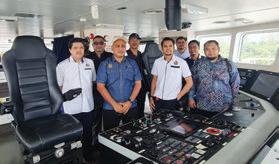
Expanding this will require significant investment and planning.
Regulatory Challenges: Adhering to international and domestic regulations related to emissions and environmental standards can be complex and costly. Shipowners must navigate a web of regulations and noncompliance may result in penalties.
Technological Readiness: Many green technologies, such as hydrogen or ammonia-powered ships, are still in the experimental stages. Stakeholders may be hesitant to adopt these technologies until they are proven to be reliable and cost-effective.
Cultural Resistance: There may be resistance within the industry to change long-standing practices and to adopt new technologies and operational procedures.
Trade-Offs with Efficiency: Improving environmental performance often comes with trade-offs in terms of operational efficiency. Shipowners may be concerned that adopting cleaner technologies will reduce the competitiveness and profitability of their vessels.
Global Nature of Shipping: The global nature of the industry means that international cooperation and coordination are essential for effective decarbonisation efforts. The lack of a unified global approach may slow down progress.
Economic Uncertainty: Fluctuating fuel prices and market conditions make it challenging for shipowners to commit to long-term investments in green technologies.
Data Collection & Reporting: Monitoring and reporting emissions data accurately can be challenging;
some vessels may lack the necessary equipment or systems to do so.
To address these, the MMD and industry stakeholders can consider implementing a combination of regulatory measures, incentives and industry initiatives such as providing financial incentives for green investments, developing infrastructure for alternative fuels, streamlining regulatory compliance, promoting research and development in green technologies and fostering international cooperation to align decarbonisation efforts.
Are there existing regulations or policies in Malaysia or ASEAN to address carbon emissions from the shipping industry?
There have been efforts made in Malaysia and ASEAN countries to address carbon emissions from the shipping industry. However, the effectiveness of these regulations and policies may have changed since then.
In 2018, IMO introduced the Initial IMO GHG Strategy, which defines the objectives, tools, pace of work and guiding principles as the framework for Member States to decarbonise shipping. ASEAN countries are expected to align with these regulations.
Malaysia has been working to implement and enforce regulations related to the protection of marine environments. While some may not explicitly address carbon emissions, they contribute indirectly to reducing the environmental impact of shipping operations.
MMD has also conducted seminars addressing environmental issues, including carbon emissions. ASEAN nations have cooperated on various environmental initiatives and there are discussions on
harmonising regulations related to the maritime sector.
What are the on-going initiatives or projects aimed at reducing carbon emissions in the maritime industry within Malaysia and the ASEAN region?
ASEAN countries often collaborate on environmental issues, including GHG emissions reduction in the shipping industry. The IMO has introduced a series of regulations to reduce GHG emissions from the global shipping industry, i.e., Marpol Annex VI (CII) and Malaysia is required to adhere to these regulations.
Meanwhile, shipping companies and organisations in the region are implementing the Ship Energy Efficiency Management Plan (SEEMP) as per IMO requirements. SEEMPs are designed to improve the energy efficiency of vessels and these involve measures such as optimising ship speed, hull cleaning and using energyefficient technologies. They have also begun exploring the use of LNG and biofuels as these produce fewer GHG emissions than traditional fuels.
On shore, ports are upgrading infrastructure to accommodate more energy-efficient vessels and to reduce waiting times while research institutions and industry stakeholders are conducting R&D
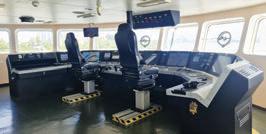
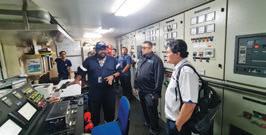
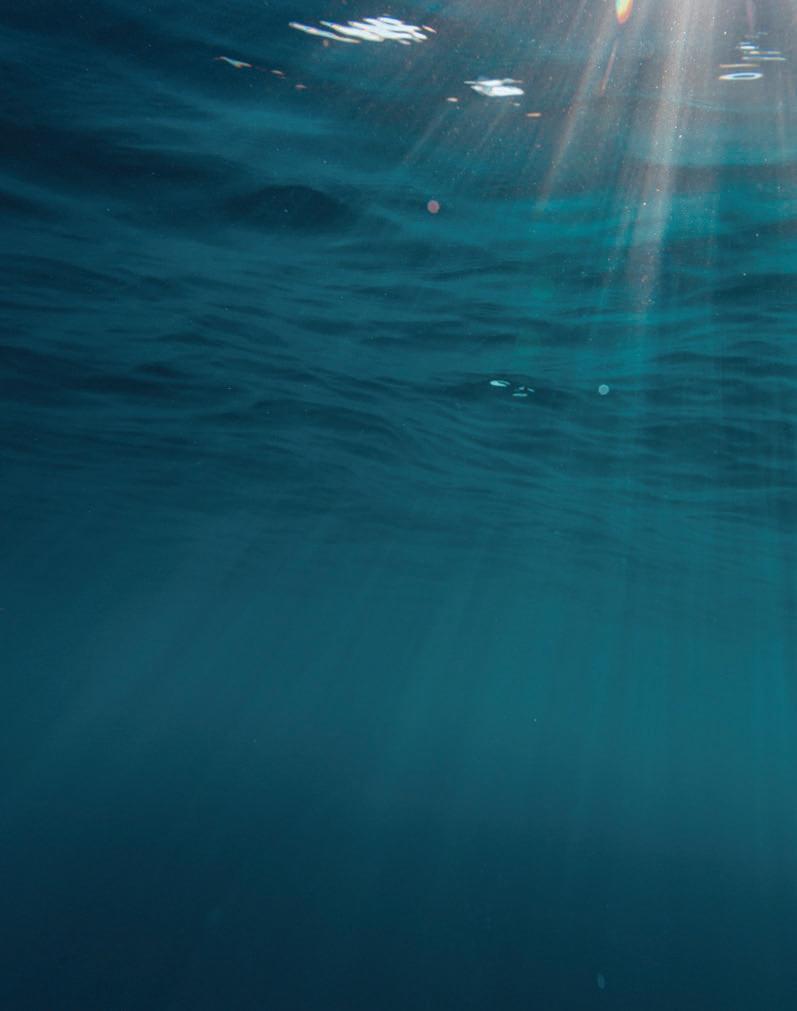
projects focused on improving the energy efficiency of ships, developing cleaner propulsion technologies and exploring innovative solutions to reduce emissions.
To track and manage carbon emissions, some shipping companies have implemented emissions monitoring and reporting systems to help them to identify areas for improvement and to reduce their carbon footprint.
How are industry stakeholders collaborating to promote decarbonisation efforts?
It is important that stakeholders, such as shipowners, operators and ports, collaborate to promote decarbonisation efforts; various initiatives and partnerships have emerged to address this challenge, including using low-sulphur fuel, slower travel time, incorporating a ballast free system, using LNG, implementing exhaust scrubber system/sulphur scrubber system, using a speed nozzle to save fuel, applying the best anti-fouling hull paint and using wind energy with the Kite-Sail and Rig-Sail systems.
IMO has been working closely with member states and industry stakeholders to implement measures such as Energy Efficiency Existing Ship Index (EEXI) and the Carbon Intensity Indicator (CII) to improve ship efficiency and reduce emissions. It will be implemented globally in July 2024.
Associations such as Malaysia Shipowners’ Association represent the interests of shipowners and operators. They actively engage in discussions and initiatives related to decarbonisation and advocate for industry-wide commitments and actions.
Ports play a crucial role and many are investing in infrastructure to support the charging and refuelling of low-carbon or electric ships. They are also working on optimising operations to reduce emissions within their boundaries.
Financial institutions are also considering the environmental criteria when approving loans/investments. Conferences, working groups and publications facilitate the sharing of
best practices, data and experiences among industry stakeholders. This helps accelerate the adoption of decarbonisation measures. Successful collaborations include the adoption of LNG as a transitional fuel, the development of hydrogen-powered vessels and the increased use of windassisted propulsion technologies. However, it’s important to note that challenges remain, such as the high cost of green technologies and the need for regulatory harmonisation on a global scale.
Name technological advancements or innovations to make vessels and shipping operations more environmentally friendly
The following initiatives are primarily driven by the need to reduce GHG emissions, improve fuel efficiency and minimise the environmental impact of maritime transportation.
a. LNG-Powered Ships: LNG is a cleaner alternative to traditional fuels, emits fewer pollutants and has lower GHG emissions.
b. Hybrid and Electric Propulsion: Some ships are adopting hybrid or fully electric propulsion systems using batteries and electric motors, particularly in smaller vessels and ferries (https://www.manifoldtimes. com/news/malaysias-first-hybridbattery-offshore-supply-vessel-willbe-designed-to-abs-rules/).
c. Wind-Assisted Propulsion: Technologies such as Feltner rotors and sail-assisted propulsion systems are being developed to harness wind power and reduce reliance on fossil fuels.
d. Alternative Fuels: Research is ongoing into alternative fuels for maritime application.
e. Energy-Efficient Hull Design: Innovations in hull design, including air lubrication systems and advanced coatings, help reduce resistance through water, improving fuel efficiency.
f. Emission Reduction Systems: Exhaust gas cleaning systems, also known as scrubbers, are being used to remove sulphur and other pollutants from ship emissions, making them compliant with stricter regulations.
g. Digital Technologies: Advanced sensors, data analytics and machine learning are used to optimise operations, route planning and cargo loading.
h. Cold Ironing and Shore Power: Ports are increasingly providing power facilities, allowing ships to turn engines off and use electricity from shore, thus reducing air pollution.
i. Emissions Monitoring & Reporting: Regulations are pushing for improved monitoring and reporting of emissions, which encourages shipping companies to reduce their carbon footprint.
j. Autonomous Shipping: Autonomous vessels can optimise routes, speed and operations more efficiently, potentially reducing fuel consumption and emissions.
k. Ballast Water Treatment: Technologies to treat ballast water, which can introduce invasive species and pollutants to new environments, are becoming more advanced and environmentally friendly.
l. Container Design/Optimisation: Innovative container designs and stacking methods help maximise cargo capacity, so fewer trips are needed which reduces emissions.
m. Environmental Certification & Standards: Organisations such as the IMO have established standards and regulations to promote environmentally friendly practices and technologies.
All these reflect a growing commitment to sustainability in the maritime sector, driven by environmental concerns and regulatory pressures to reduce the carbon footprint. Many are being adopted gradually to achieve sustainable and eco-friendly shipping in the long term.
What roles do alternative fuels and energy sources play?
Liquefied Natural Gas (LNG): LNG is a relatively cleaner fuel with less GHG emissions, sulphur oxides (SOX) and particulate matter. By using LNG, ship operators can comply with

increasingly stringent emissions regulations such as the IMO’s sulphur cap regulations.
Retrofitting existing vessels to run on LNG and incorporating LNG propulsion systems in new ship designs are viable options to reduce emissions and developing LNG bunkering infrastructure is essential to support the adoption of LNG as a maritime fuel.
Hydrogen: When produced from renewable sources or through electrolysis using renewable energy, hydrogen is a zero-emission fuel that can be used to generate electricity for electric propulsion systems, providing a clean and efficient power source for ships. Thus, it is crucial to establish infrastructure for hydrogen production, storage and distribution to enable the adoption of hydrogen as fuel.
Electric Propulsion: Electric propulsion systems, including battery-electric and hybrid-electric systems, can help reduce emissions by using electricity from clean sources or stored energy during lowload operations. Electric propulsion systems offer higher energy efficiency and lower maintenance costs than internal combustion engines. Developing shore power infrastructure will enable ships to connect to the grid and reduce their emissions while docked.
To effectively decarbonise the maritime sector, several factors must be considered. Governments and industry stakeholders must invest in research and development, infrastructure and incentives to make alternative fuels and electric propulsion economically viable. It is essential to develop and implement regulatory frameworks that promote the use of cleaner fuels and technologies while ensuring safety and compliance and to build infrastructure for alternative fuel production, storage and distribution as well as establishing LNG bunkering and hydrogen refuelling facilities at ports.
Collaboration among governments, shipowners, shipbuilders and technology providers is crucial to drive the adoption of alternative fuels and propulsion systems just as training
and educating maritime professionals on the benefits and operation of alternative fuels and technologies is essential for successful implementation.
In conclusion, LNG, hydrogen and electric propulsion can significantly reduce carbon emissions in the maritime sector. However, these require a coordinated effort involving all stakeholders and the government.
How does the shipping industry align with the UN SDGs?
We align with the UN SDGs by addressing environmental, social and economic challenges.
a. SDG 13 (Climate Action): This is one of the most relevant SDGs as the maritime and shipping industry contributes to GHG emissions from the burning of fossil fuels. We need to adopt cleaner fuels, improve vessel efficiency and explore alternative propulsion technologies.
b. SDG 7 (Affordable & Clean Energy): To achieve this we must transition to cleaner energy sources (energyefficient technologies and renewable energy such as wind and solar power).
c. SDG 9 (Industry, Innovation & Infrastructure): Improving infrastructure and fostering innovation can lead to more sustainable practices and technologies. Investments in cleaner and more efficient vessels, port facilities and transportation infrastructure can support this goal.
d. SDG 14 (Life Below Water): Sustainable practices such as preventing oil spills, reducing pollution and protecting marine ecosystems, contribute to the conservation and sustainable use of marine resources.
e. SDG 15 (Life on Land): Reducing the environmental impact of shipping operations by minimising invasive species transportation and preventing pollution, aligns with efforts to protect terrestrial ecosystems.
f. SDG 12 (Responsible Consumption & Production): We can support this SDG by optimising cargo loads, reducing waste as well as
adopting sustainable materials and practices in shipbuilding and maintenance.
g. SDG 11 (Sustainable Cities & Communities): Ports are often located in or near urban areas. Sustainable port operations and integrated transportation systems can contribute to more sustainable and resilient cities and communities.
h. SDG 8 (Decent Work & Economic Growth): Improvements in labour conditions and worker safety align with this goal.
i. SDG 17 (Par tnerships for the Goals): Collaboration between governments, industry stakeholders and international organisations is essential for achieving all the SDGs, including the maritime sector. Partnerships foster knowledge sharing, innovation and the implementation of sustainable practices.
It’s important to note that the alignment of the maritime and shipping industry with the SDGs requires a multi-faceted approach involving regulatory changes, technological advancements and industry-wide collaboration. As climate change and sustainability become pressing concerns, the industry’s decarbonisation efforts play a pivotal role in achieving several SDGs, with SDG 13 being the most immediate and impactful focus area.
Are there any financing mechanisms or incentives to support sustainable and low-carbon shipping practices in the region?
There are but the availability and specifics of these mechanisms vary from one region to another. Businesses can consult relevant government agencies, industry associations and financial institutions.
International organisations and funds, such as the IMO and the Green Climate Fund, may provide financial support for projects aimed at reducing emissions and promoting sustainable shipping practices. Some governments offer subsidies and grants for shipping companies to invest in cleaner, more sustainable
technologies such as retrofitting vessels with emission-reducing technologies or for the construction of more eco-friendly ships.
Apart from this, governments and organisations do provide funding for research and development projects related to sustainable shipping technologies. Businesses can access these resources to develop and test new low-carbon solutions.
Financial institutions, including banks and development organisations, may also provide specialised loan products with favourable terms for projects that contribute to sustainability. These loans will help shipping companies purchase cleaner and more efficient vessels.
Tax credits and deductions can be provided to shipping companies which adopt sustainable practices or invest in low-carbon technologies. These incentives will reduce the tax burden and make green investments more attractive.
Some ports offer fee discounts or incentives to ships that meet specific environmental criteria, such as using cleaner fuels or reducing emissions. These will help lower operating costs for shipping companies.
However, to access these resources and incentives, businesses need to meet eligibility criteria and to follow application processes established by the relevant authorities or organisations. But as policies and incentives can change over time, it’s
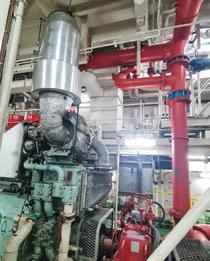
essential that businesses stay informed of the latest developments.
What are the most critical steps or initiatives that need to be undertaken to accelerate the decarbonisation of the marine and shipping industry in Malaysia and ASEAN region, particularly in terms the SDGs? Here are some critical steps and initiatives that need to be undertaken to accelerate decarbonisation in this industry:
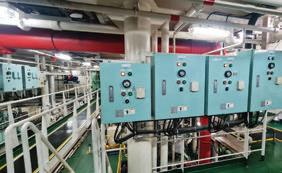
R&D: Invest in R&D for cleaner and more efficient maritime technologies, including alternative fuels as well as support the development of energyefficient ship designs and propulsion systems, such as wind-assist technologies and electric propulsion.
Renewable Energy: Encourage the use of renewable energy sources in port operations, such as solar panels and wind turbines to power port facilities and docked ships as well as provide financial incentives, tax breaks or subsidies for the adoption of renewable energy solutions.
Green Ports and Infrastructure: Develop green ports with shore power facilities to enable ships to connect to electricity while in port, thus reducing the need for onboard generators. Implement sustainable port infrastructure and practices, including efficient cargo handling and reduced emissions from port equipment.
Regulatory Frameworks: Establish and enforce stringent emissions regulations for ships operating in ASEAN waters, including limits on sulphur and nitrogen oxide emissions. Consider implementing carbon pricing mechanisms, such as a carbon tax or emissions trading scheme.
Building & Training: Provide training and capacity-building programmes for maritime professionals to operate and maintain cleaner and more efficient technologies. Develop educational programmes to raise awareness of the importance of decarbonisation.
Collaboration: Foster collaboration among ASEAN countries to create a unified approach to decarbonisation. Engage with international organisations and partnerships focused on sustainable shipping, such as the IMO and the Getting to Zero Coalition. On the global platform, engage with international partners to address cross-border issues related to shipping emissions and pollution and participate in global efforts to develop and implement low-carbon shipping technologies and practices.
Financial Support and Incentives: Establish green financing mechanisms and incentives for shipowners to invest in cleaner vessels or to retrofit older ones. Promote green bonds and other financial instruments to fund sustainable shipping projects.
Data and Monitoring: Develop a comprehensive data collection and reporting system for tracking emissions in the maritime sector. Use digital technologies like IoT and AI for real-time monitoring of emissions and fuel efficiency.
Public Awareness: Raise public awareness of the environmental impact of shipping and the benefits of decarbonisation. Encourage consumers to choose products and services that prioritise sustainable shipping practices.
A multifaceted approach involving government policies, industry collaboration, technology innovation and public engagement is required to accelerate decarbonisation in the industry. Aligning these efforts with the SDGs can help ensure a
sustainable and prosperous future for the region.
How will international collaborations and partnerships contribute to decarbonisation goals?
International collaborations and partnerships can play a huge role in reducing emissions and transitioning to a more sustainable maritime industry.
Through collaboration, countries and organisations can share data, research and best practices related to maritime emissions reduction as well as information on policy measures and incentives while nations learn from each other’s experiences and adopt effective policies more quickly. This will help identify effective strategies and technologies for reducing carbon emissions. It will also facilitate joint research and development efforts to create innovative, lowcarbon technologies, including the development of cleaner propulsion systems, alternative fuels and more energy-efficient ship designs.
Collaborative efforts can help align international regulations and standards to ensure a level playing field for all stakeholders and to reduce the potential for regulatory arbitrage. It can lead to joint R&D projects to solve common challenges such as projects focused on reducing emissions, enhancing energy efficiency and improving vessel design. Developing countries or regions may lack the expertise and resources needed to adopt lowcarbon technologies. International partnerships can provide training and capacity-building programmes to help them transition to cleaner maritime practices.
International collaboration can attract funding and investments from multiple sources, including governments, international organisations and the private sector to support the development and deployment of green technologies and infrastructure. Collaborative efforts can also lead to economies of scale in the production and deployment of green technologies.
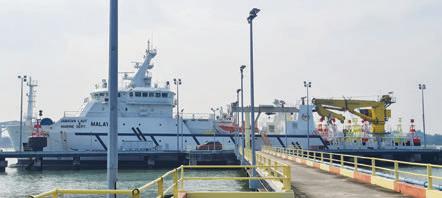
This can reduce costs and make it more affordable for the maritime sector to transition to cleaner options. It will also enable the establishment of international monitoring and reporting mechanisms for maritime emissions which will ensure that countries and organisations are held accountable for their emissions reduction commitments.
Tell us some success stories of effective decarbonisation in the shipping industry from Malaysia or ASEAN, especially with respect to alignment to SDGs
a. Malaysia’s Green Ship Programme: This programme aims to incentivise shipowners to adopt more environmentally friendly technologies and practices, such as cleaner fuels and energyefficient technologies. Aligning with SDG 13, this initiative focuses on reducing the carbon footprint of the industry.
b. Singapore’s Maritime Green Initiative: The Maritime & Port Authority of Singapore (MPA) has launched the Maritime Singapore Green Initiative, which promotes sustainable shipping practices. It includes incentives for ships that meet specific environmental performance standards such as EEXI and CII. This initiative aligns with SDG 13.
c. Indonesia’s Biodiesel in Maritime Transport: Indonesia has been working on utilising biodiesel in its maritime transport sector. Biodiesel from sustainable sources can significantly reduce GHG
emissions. By promoting the use of sustainable biodiesel, Indonesia is making strides in SDGs 13 and 7.
d. ASEAN Framework on Sustainable Shipping: ASEAN is working on a regional framework for sustainable shipping practices aimed at harmonising regulations and standards across member nations, promoting environmental sustainability and supporting SDG 14s and 17.
e. R&D Collaborations: Various universities and research institutions in ASEAN countries are collaborating with international partners to develop and test innovative technologies for decarbonising the shipping industry. These collaborations contribute to advancing SDGs 9 and 17.
f. Green Port Initiatives: Several ports in ASEAN have initiated green port programmes focused on reducing emissions, optimising energy use and promoting sustainable practices within the port facilities. These align with SDGs 13 and 11.
It’s important to note that the success of these initiatives and best practices depends on various factors, including government policies, industry collaboration and technological advancements. As global focus on decarbonisation continues to grow, these examples serve as starting points for addressing sustainability challenges in the maritime and shipping industry in the ASEAN region while aligning with the UN SDGs.
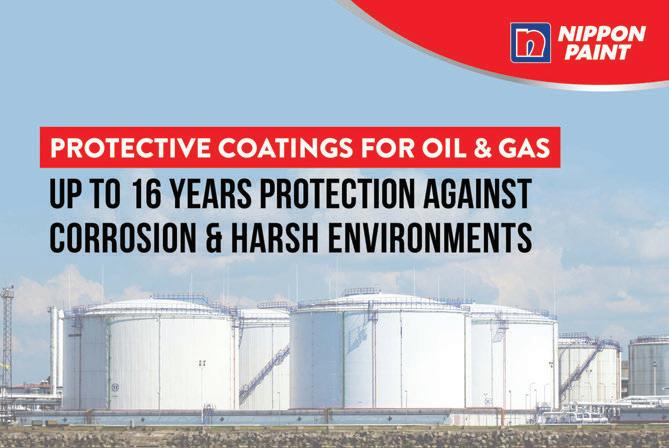

1. Can you please elaborate on the expansion of your business into the oil and gas sector?
Nippon Paint has been providing protective coatings solutions for various industries for over 100 years. The sectors include original equipment manufacturing (OEM), oil and gas, power, infrastructure and industrial, as one of the few companies globally to achieve this milestone. We have certified inspectors by the Institute of Materials Malaysia (IMM) and the Association for Materials Protection and Performance (AMPP). To compete in the market, we have increased our innovative research and development (R&D) to invent solutions. In total, we have 15 R&D centers across Asia, with over 56 years of innovative research.
2. The construction sector contributes a significant impact on social and economic. Does Nippon Paint have any plan to collaborate with organisations in order to penetrate and fulfill the sector?
Recently, we just entered into collaboration with PETRONAS and their Advanced Materials team to use ProShield+, its graphene-based paint additive to expand and improve the quality of our protective coatings for Oil and Gas industry use.
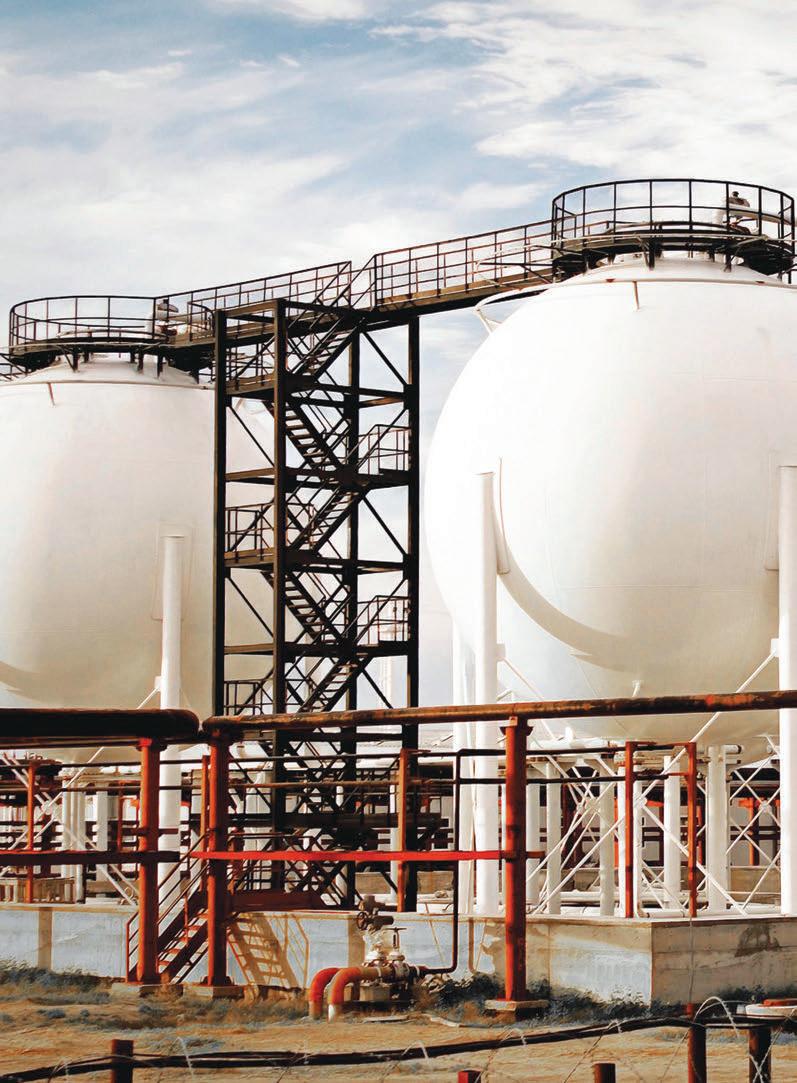
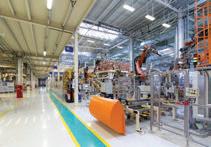
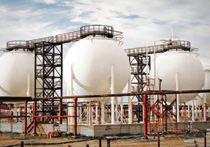
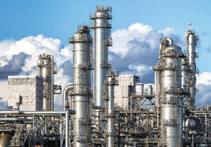
As part of our effort to strengthen the protective coatings business, Nippon Paint offers a new range of products called Nippon Paint 9049 GR which is infused with GrapheneTec+ Technology powered by ProShield+. The product has been launched under a new technology called GrapheneTec+, which anchors on the additive’s ultra-high barrier properties proven capable of strengthen coating’s corrosion resistance against harsh weather conditions and doubling the lifespan of the average coated steel.
GrapheneTec+
is built for the Oil & Gas and heavy industries with excellent corrosion resistance, improved wear resistance and superior thermal stability against harsh weather conditions.
In addition, Nippon Paint has a range of products that conform to the PETRONAS Technical Standards (PTS), while catering to the needs of new construction, maintenance and repair.
We hope that this collaboration will not only widen Nippon Paint’s presence in the coating industry but strengthen its position as a Total Coating & Construction Solutions (TCCS) provider. Moving forward, we look forward to working together with other major corporations in the future.
3. Can you explain how the collaboration with PETRONAS in the Advanced Materials space brings value to the oil and gas industry?
We believe that this collaboration with PETRONAS raises the bar in product innovation to cater to the oil and gas industry’s demands. Through this collaboration, Nippon Paint foresees that it can increase its competitive edge in new markets by enhancing its product innovation to meet evolving market demands.
For instance, with the advanced technology in our new product offering Nippon Paint 9049 GR infused with GrapheneTec+ powered by ProShield+, we are able to reduce the cost of repainting as the additive is formulated for a superior performance of 3x higher corrosion resistance, 3x higher abrasion resistance and 2x longer lasting.
We hope that our product innovation will be able to contribute more value to the oil and gas industry.
4. With the recent collaboration with PETRONAS, how does Nippon Paint contribute to the market segment?
Through our collaboration with PETRONAS, Nippon Paint aims to increase its market share in the B2B Business from 42% to 60% by 2025. This is driven by higher performance and quality coating.
Following that, Nippon Paint aims to enter the global oil & gas market as well as offer a real chance for productivity gains, efficiency improvements, and innovation within this industry.
5. What are the long-term goals of this cooperation with PETRONAS and the prospects presented by Nippon Paint?
The collaboration between Nippon Paint and PETRONAS marks an exciting milestone in the realm of protective coatings for the oil and gas industry, particularly through our innovative GrapheneTec+ technology. The long-term goals of this cooperation are to revolutionise and enhance the performance of protective coatings used in the oil and gas sector. By leveraging our expertise in coatings and PETRONAS’ extensive knowledge of the industry, we aim to develop coatings that provide unmatched durability, corrosion resistance, and operational efficiency, ensuring enhanced protection for critical infrastructure.
Since this is our first collaboration with PETRONAS, we aim to collaborate on programs that are successful and will change the way Nippon Paint scales and expands. Nippon Paint is prepared to lay the proper basis for success that will enable us to grow exponentially and provide PETRONAS and its clients with greater value.

Written and Prepared by:


With USM since 1999, Ir. Ts. Prof. Dr Mohd Rizal Arshad’s fields of expertise are Robotics & Industrial Automations, Measurement & Instrumentation Techniques, Biomedical Electronics & Medical Imaging and Underwater Robotics Technology.

8 years’ experience in design and development robotics systems for Underwater Inspection and Culvert/Sewerage Inspection.
Professor at the Faculty of Ocean Engineering Technology & Informatics in Universiti Malaysia Terengganu since 2008, Director of International
and
Autonomous surface vehicles (ASVs) and sophisticated data handling and visualisation modules offer a comprehensive solution for port structure inspections. Port inspection refers to the examination of surface structures that are inaccessible for inspection due to location and positioning of the port/ jetty platform. Because of this, there will be limitations for manual inspections.
ASVs are equipped with advanced sensors that improve their efficiency, accuracy and safety. Using them also eliminates the risks and expenses of manual inspections. In addition, their ability to navigate difficult terrain and access remote locations will ensure a more thorough examination, decreasing potential oversights and raising overall operation safety.
By incorporating the artificial intelligence (AI) module, an assurance of enhanced accuracy and reliability in data representation is achieved. The processed data, along with accompanying information, will be translated into a 3D digital model. This model will feature a virtual reality (VR) simulator designed for the ASV and a virtual version of the actual data. The implementation of intelligent ASV systems will not only optimise operational efficiency but will also elevate the overall performance and longevity of maritime assets.
Regular inspections of port structures are essential to ensure the safety, functionality and durability of these maritime assets. When inspections are conducted regularly, potential structural problems can be identified and fixed
quickly. This proactive approach is vital for keeping the infrastructure strong and preventing accidents which, in turn, safeguards both workers and vessels. Moreover, inspections are instrumental in spotting early signs of wear and tear, allowing for timely repairs and maintenance. Addressing issues early on helps prevent expensive and disruptive emergency repairs.
Traditionally, inspecting ports involved using boats operated by humans to take pictures and videos with cameras but this had several significant drawbacks. One major concern was the potential for human error which could compromise the accuracy and reliability of the inspections. Moreover, this method had limitations in terms of coverage as certain areas might be inaccessible, leaving potential security threats unnoticed. Additionally, the process was time-consuming due to the manual operation and capturing of images, which could slow down the inspection process and result in delays in addressing issues.
Safety was also compromised as there were risks associated with operating boats in busy port environments, particularly during high tide when accessing certain areas of port structures became challenging and dangerous. Furthermore, the traditional method lacked scalability as it relied heavily on human resources. Ensuring consistency in the inspection process across different operators was a challenge. The physical limitations and fatigue experienced by personnel could hinder the effectiveness of the inspections. Inefficient coverage and the possibility of missing hazards collectively undermined the overall safety of the port.
The pros and cons of both the traditional method and using an unmanned vehicle for underwater inspection depend on the specific task and environment in which it is performed. Tables 1 and 2 show the advantages and disadvantages of both methods.
• Real-time decision-making
• Physical interaction
• Safety issue
• Remote operation
• Cost efficiency
• Reduced downtime
• Consistent data collection
• Continuous operation
• Safety issues and risk to inspectors
• Hazardous environment (harsh weather)
• Limited data collection
• Cost-effective
• Limited physical interaction
• Data processing requirements
In response to these challenges, advanced technologies have emerged as promising alternatives. These include using AI and digital twins, along with automated methods such as ASVs. This innovative approach holds the potential for enhancing accuracy, coverage and efficiency while giving top priority to the safety of personnel during inspections. By adopting these new inspection methods, managements of ports and jetties can overcome the limitations of the traditional approach and ensure a comprehensive enhancement of security and operational effectiveness for their structures. Incorporating AI technology empowers ASVs to process and understand the collected data autonomously, adding an extra layer of accuracy and efficiency to the inspection process. Furthermore, ASVs offer a solution by combining automation, advanced technology and AI to ensure comprehensive assessments, improved safety and efficient maintenance practices.
Enhancing ASVs for the inspection of port structures entails the use of AI technologies. These adept computers proficiently identify issues in the images, such as cracks or damage. AI can analyse patterns and disparities to detect any anomaly. ASVs capture data (images and videos), offering valuable insights into the structures. This enhancement helps predict potential issues to ensure the durability of structures in ports and jetties. With AI integration, ASVs have become invaluable for thorough port inspections, ensuring accuracy and reducing reliance on human assistance.
Digital twins and VR are revolutionising industries with their groundbreaking applications. Pictures are used to create a 3-D digital replica of real-world structures such as ports and jetties. With digital twins, potential issues can be identified and analysed without the need for on-site visits. Meanwhile, VR will immerse users, enabling them to navigate these structures (similar to that in a game), enhancing operator training for ASVs.
These technologies not only streamline inspections but also make training engaging and bolster the longevity of infrastructure like ports and jetties. At its core, a digital twin is a virtual replica of a physical object, process or system. The architecture of a digital twin is multi-layered but it fundamentally rests on three pillars.
Our products:




No. 45-3, Jalan PJU 5/20
The Strand, Kota Damansara 47810 Petaling Jaya Selangor Darul Ehsan
Tel : 603 6142 6638
Fax : 603 6142 6693
Email : jasonklc@nehemiah-grp.com
Email : julia@nehemiah-grp.com


1. The real-world entity can range from a simple object to a complex system.
2. There’s digital representation of this entity in the virtual world.
3. Finally, and perhaps most crucial, is the data, the conduit that ensures that the digital representation is always in sync with its physical counterpart. The intricate interplay between the 3 components makes the concept of digital twins so transformative. The digital twin has a very distinctive feature: Real-time data synchronisation. With a digital twin, every nuanced change in the physical entity, no matter how minute, is immediately mirrored in the virtual representation. This dynamic relationship means that as operations evolve and proceed, both the tangible and virtual entities always remain in tandem, painting a consistent and harmonised picture. Figure 1 shows an example of digital twin and use of VR.
VR offers a simulated experience that utilises physical pose tracking and near-eye displays, immersing users in a meticulously constructed virtual world. Unlike ordinary digital experiences, it intricately mirrors the surroundings, permitting the user to remain stationary while still engaging wholly with the encompassing environment. This advanced technology has found its application in diverse sectors. There are other notable variants, such as augmented reality (AR) and mixed reality (MR). Unlike traditional VR, these technologies combine the real and virtual worlds. They superimpose digital information onto the immediate environment and facilitate a dual interaction, allowing users to engage with their physical surroundings and the augmented layers simultaneously. The advanced applications of VR technologies, including AR and MR, have significantly enhanced control and visualisation processes. Such advancements pave the way for a more harmonised human-computer interaction and set the stage for the future of port and jetty structure inspection.
In underwater structure inspection at ports and jetties, the use of ASVs instead of humans, is a considerable step forward in terms of efficiency and technological progress. The benefits of ASVs, such as increased safety, reliable data
collecting and fewer operational interruptions, highlight their critical role in upgrading inspection processes.
While human inspectors have the advantage of real-time decision-making and physical interaction, safety hazards are evident challenges. ASVs with AIdriven image processing analysis have demonstrated their abilities in accurate data collection and predictive maintenance, together with the use of digital twin approach and VR representations. As technology advances, a combination of human skills and technical innovation will pave the way for a more balanced and effective approach to ensuring the integrity and durability of critical port and jetty infrastructure.
[1] Kang, H., Kim, S., and Yoon, K. (2016). Autonomous Surface Vehicle for Harbor Surveillance. Journal of Navigation and Port Research, 40(6), 445-451.
[2] Watson, J., and Raimondi, A. (2018). Integrated Autonomous Surface and Underwater Vehicle for Port Security. IEEE Transactions on Intelligent Transportation Systems, 19(11), 3662-3673.
[3] Li, J. et al. (2020). AI-Based Autonomous Navigation for ASVs in Port Environments. IEEE Transactions on Robotics, 36(4), 1073-1088.
[4] Truong, M.T.N. and Sanghoon, Kim. (2018).Automatic Image Thresholding Using Otsu’s Method and Entropy Weighting Scheme for Surface Defect Detection. Software Computing. Vol. 22. pp. 4197-4203.
[5] A.Norhairi, A.N. et.al (2021). Detection of Void Regions in Single Pad X-ray Images Using Image Processing Approach. Proceedings of International Conference on Robotics, Vision, Signal Processing, and Power Applications. 5 – 6 April 2021. Penang, Malaysia.
[6] Majeed, S.H. (2022) New Modified Histogram Equalization Based Local Contrast Enhancement Methods. PhD Thesis. USM
[7] Saad, N. H., M. Isa,N.A., and M. Saleh, H.(2021). Nonlinear Exposure Intensity Based Modification Histogram Equalization for Non-Uniform Illumination Image Enhancement. IEEE Access. Vol 9. pp. 93033 –93061. Paper No 9465139
[8] Saad, N. H. (2022).Nonlinear Exposure Intensity-Based Histogram Equalization for Non-Uniform Illumination Image. PhD Thesis. USM.
[9] V.D. Oord,A., Dieleman,S., and Schrauwen.B. (2013). Deep content-based music recommendation. In Proc. 26th Int. Conf. Neural Inf. Process. Syst. (NIPS), Lake Tahoe, NV, USA, vol. 2, 2013, pp. 2643–2651.
Workshop on Dispute Avoidance No. 7 (Physical) - Rescheduled from 23 September 2023
Date : 9 December 2022 (Saturday)
Time : 9.00 a.m. – 12.00 p.m.
Venue : Wisma IEM
Approved CPD : 3
Speakers : Ir. Zafrul bin Mahmood, Ir. Leon Weng Seng, Ir. Ho Kin Wing, Ir. Ang Kok Keng
Written and Prepared by:

The transportation sector is a critical area of growth for our national economy. Every year, it makes a significant contribution to Malaysia’s gross domestic product by creating high-skilled jobs, playing a role in international trade and being a major source of fiscal income for national treasury. However, this sector is also the third largest contributor of CO2 emissions with approximately 23% (Figure 1) of annual global figure1. These emissions contribute significantly to global warming and climate change.
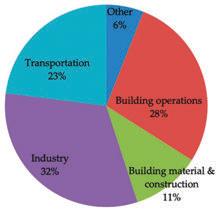
Maritime transportation in global logistics has also been increasing steadily, resulting in an increase of emissions rates which is now a cause for great concern. Shipping vessels depend heavily on fossil fuels which produce harmful greenhouse gases (GHG).
Shipping accounts for about 3% of total CO2 emissions worldwide. These emissions are attributed to the use of heavy fuels, which accounts for more than 50% of the operating costs in shipping. In essence, the type of fuel used for sea freight forwarding is of paramount importance to environment.
The global increase in CO2 emissions increases the gas barrier around the world, resulting in global warming. This leads to a chain of catastrophic events such as changes
in average sea level, variations in climate conditions and rainfall patterns. If higher concentrations of CO2 are inhaled, humans and animals may suffocate. Plants too will react significantly to these changes. Plants are important for photosynthesis, which is the key to sustaining the entire life system on the planet. Figure 2 shows five categories of risk and impact global warming correlated to future temperature increase 2 .
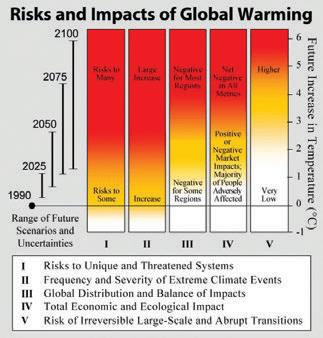
The maritime industry relies largely on heavy fuel oil which is more accessible and cheaper than other resources. However, heavy fuel contains sulphur and other environmentally harmful impurities as it is a residue of oil refining.
In 1997, an annexe was added to the International Convention for the Prevention of Pollution from Ships (MARPOL). The Regulations for the Prevention of Air Pollution from Ships (Annex VI) seeks to minimise airborne




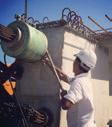
emissions from ships and carbon intensity of global shipping to eliminate its contribution to local and global air pollution and environmental problems. It was enforced on 19 May 2005 and since then it has been continuously changing in line with the commitment that Member States made within International Maritime Organisation (IMO) to limit the harmful effects of air pollution and GHG emissions from international shipping on human health and the environment. IMO works in 3 ways to achieve the goals. These aspects are defined as levels of ambitions in the strategy:
1. Declining the carbon intensity of ships with the help of the Energy Efficiency Existing Ship Index (EEXI) (Figure 3).
2. To reduce the Carbon Intensity Indicator (CII) of international shipping (Figure 4).
3. For the GHG emissions from international shipping to peak and decline. Shipping companies need to use better (and therefore more expensive) fuel with diesel-like components. For comparison, the Euro5 environmental diesel, which is currently used for land-based transportation in most developed and developing countries in the world, has a lower sulphur content. The sulphur content of fuel oil predominantly used in large bulk vessels, is higher than diesel fuel of the highest environmental standards available. So in 2016, IMO initiated the transition of the entire world civil fleet from January 2020 to use marine fuel with lower sulphur content.




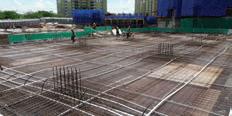
The Strand, Kota Damansara 47810 Petaling Jaya
Selangor Darul Ehsan
Tel : 603 6142 6638
Fax : 603 6142 6693

Email : enquiry-pt@nehemiah-grp.com

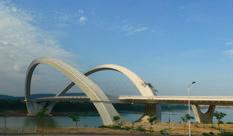
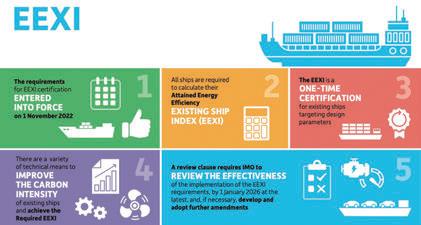
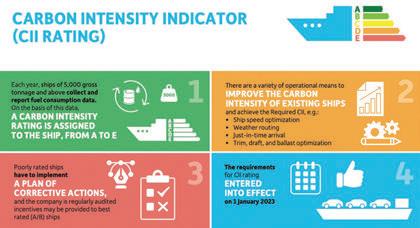
Amendments to MARPOL Annex VI entered into force on 1 November 2022. Under the IMO Strategy on Reduction of GHG in 2018, these amendments require ships to improve their energy efficiency in the short term to reduce their GHG emissions. All ships must calculate their attained EEXI to measure
their energy efficiency, and initiate collection of data to report their operational CII and CII rating. The IMO target is to reduce the carbon intensity of all ships by 40% in 2030 compared to the 2008 baseline.
Many ship operators face the challenge of managing the available choices and adapting to the requirements of the IMO.
Special Exhaust Gas Purifier-Scrubbers: This is a piece of equipment that filters (or scrubs) harmful sulphur oxides in exhaust gases from main engines and generators. This way, high-sulphur fuel can be used and yet, at the same time, comply with standard for harmful substances in exhaust gases3. Today, more and more vessels are equipped with this equipment.

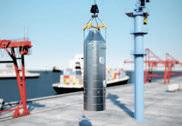
New Formulated Fuel: Most shipping companies are now using a special very low sulphur fuel oil4 with a sulphur content that is 7 times lower and thus, IMO compliant.

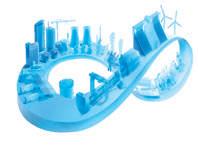
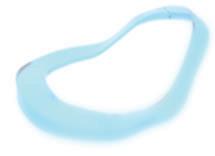


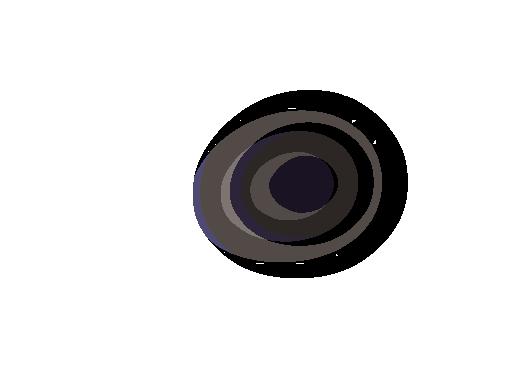
Green Energy: The shipping industry is not only shifting to cleaner fuels based on oil but is also considering alternative sources of energy such as solar and wind power. Other innovative developments are more efficient systems, such as higher engine efficiency and better water cooling (which dramatically reduces the environmental impact), Kite-Sail and Rig-Sail systems. At the moment, Kite-Sail has yet to be utilised in any ship, probably due to its low Return on Investment (ROI).

An optimised cooling system can save on use of electricity and fuel. Greener engines can minimise NOx output and up to zero SOx emission (with the use of scrubbers). The industry is also focusing on the use of solar panels in ships to reduce fuel consumption and attain zero harmful emissions. Newly developed propellers also can reduce fuel consumption. Moreover,

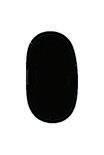
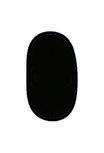
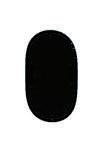
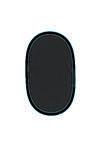
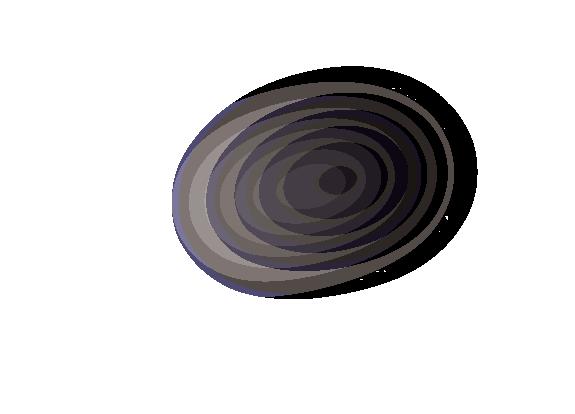

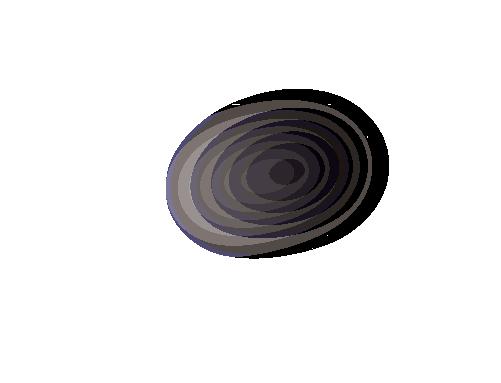




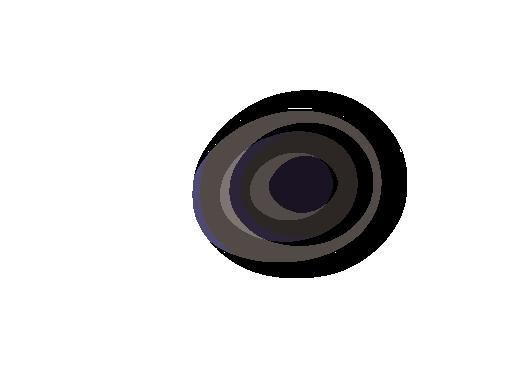
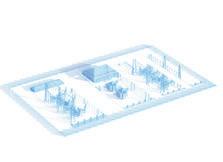
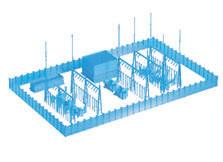
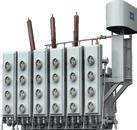









the speed injector, which improves efficiency at high speeds also can reduce fuel consumption. The same goes for new body paint technologies which can reduce friction and positively affect fuel consumption.
Fuel Optimisation System: This system collects data from sensors on the ship, satellites and embedded trackers and processes the information using machine learning algorithms. Then it presents recommendations on the optimal route in terms of economy as well as statistical and analytical reports for management decisions on when to clean and repaint and when to carry out preventive or corrective maintenance.
Battery Storage: Progress in energy storage such as all-electric ships, will hasten decarbonisation. Norway has launched its first ship upgraded to a battery-hybrid model. The Yara Birkeland, the world’s first net-zero, batterypowered autonomous container ship, was delivered to Norwegian fertiliser company Yara Norge AS in November 2020. It is currently in the Norwegian port of Horten, where it is undergoing preparation for operation.
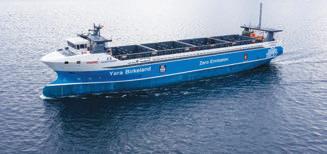
Internal Management Control (IMC): To comply with the IMO regulations, ships will be audited by Recognised Organisations (RO) appointed by the Malaysia Marine Department. From the audit review, the ship’s crew will do the IMC to prevent air pollution (carbon emission). The IMC includes slowing down the speed to reduce shipping emissions, avoiding unnecessary loads such as empty containers and using the latest technologies.
Conclusion
There are various methods to implement carbon reduction in the shipping industry. If proper methods and processes are followed, it will indirectly affect surrounding conditions, especially in terms of the safety for flora and fauna. Reducing carbon emissions will positively impact the maritime industry as more and more ships will be involved in transportation, thus enhancing economy of our country.
[1] K. A. Ali, M. I. Ahmad, and Y. Yusup (2020). Issues, Impacts, and Mitigations of Carbon Dioxide Emissions in the Building Sector, Sustainability (Switzerland), Vol. 12, No. 18, Sep. 2020. Doi: 10.3390/ Su12187427.
[2] U. Shahzad (2017). Global Warming: Causes, Effects and Solutions. [Online]. Available: https://www.researchgate.net/ publication/316691239.
[3] H. Winnes, E. Fridell, and J. Moldanová (2020). Effects of Marine Exhaust Gas Scrubbers on Gas and Particle Emissions, J Mar Sci Eng, Vol. 8, No. 4, Apr. 2020.Doi: 10.3390/Jmse8040299.
[4] A. Davinić, R. Pesic, D. Taranović, S. Milojević, and R. Pešić (2015) .The Use of Modern Fuels in Diesel Engines of the Older Generation. [Online]. Available: https://www.researchgate.net/ publication/323970377
Virtual 2-Day Course on Understanding Construction Contracts
- Failures and Remedies
Date : 12 - 13 December 2022 (Tuesday - Wednesday)
Time : 9.00 a.m. – 5.30 p.m.
Venue : Digital Platform
Approved CPD : 14
Speaker : Ir. Lai Sze Ching
Virtual One-Day Course on Government Asset Management
- Building Performance Assessment
Date : 14 December 2022 (Thursday)
Time : 9.00 a.m. – 5.00 p.m.
Venue : Digital Platform
Approved CPD : 14
Speaker : Ir. Ts. Dr Mohamad Adzizulrohim bin Abd Malek
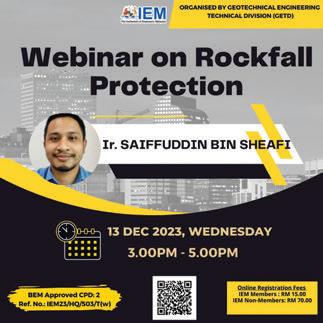
Written and Prepared by:

Teo
10 years’ experience in sheet metal and heavy steel fabrication. He manages site construction activities in a multinational corporation based in offshore oil and gas facilities in Terengganu.
Welding is a process where two or more parts of “parent material” are fused together via heat and/or pressure to form what is referred to as “weldment”. Some welding processes require consumables (flux or filler materials) while others do not, such as “resistance spot welding”. Current welding technology available can be applied on metals, thermoplastics and even wood.
However, utilising the welding process on steel is still the most common today. Many small and medium size fabricators in Malaysia treat welding as a simple manufacturing process without referring to specific codes or standards. Nonetheless, it all depends on customer requirements and the needed quality assurance on product.
So, how does one produce a weldment of reasonable quality meeting a specific standard? The answer is by utilising a Welding Procedure Specification (WPS). Basically, WPS is a formal internal document that welding companies use to instruct welders or welding operators on how to achieve production weld that meets the relevant code requirement and this is usually associated with quality. The following section illustrates the steps to creating a WPS.
A good quality weldment can be long lasting and depends on various factors to achieve. For repeatable purpose, a systematic approach is used in qualifying the welding procedure and welder which is referred to as Welding Procedure Specification and Welder Qualification Test respectively. In order to develop a good quality weld, we need to understand the end use and the best way to find out is through engineering drawings. The technical drawing itself will most likely spell out the design specification which will subsequently allow one to determine the governing welding code and standard. If not, one may
communicate with the stakeholder/customer directly to determine the requirement.
Should the governing welding code not be known, the fabricator or contractor may propose to the stakeholder the closest welding code or standard available in the market. With the information in-hand, a proposed or preliminary Welding Procedure Specification (pWPS) can be developed based on the preferred welding process, base metal type, welding consumable selection, and other key factors. All these factors which will affect the quality outcome of the weldment are classified as Essential Variables. For instance, the welding consumable selected needs to be compatible with the welding process and be suitable for the base metal, both in terms of physical and chemical properties in order to deliver the expected outlook.
With the pWPS finalised, a Welding Procedure Qualification Test (WPQT) can be conducted where the welding is done on a test coupon, in accordance with the pWPS guidelines and predetermined variables. Subsequently, the prepared test coupon will undergo NonDestructive Testing (NDT) before it is sent to a recognised laboratory for physical testing (and a chemical test, if needed). In the event that the laboratory test result does not meet the anticipated outcome, the pWPS will have to be revised and the WPQT repeated until the desired outcome is achieved. Any change in the variables observed during the WPQT needs to be recorded for post-mortem failure root cause study.
• A WPQT Test Coupon NDT usually comprises radiographic testing and Magnetic Particular Inspection (MPI)/Dye Penetration Inspection (DPI) to ensure no rejected defect exists in the test coupon, internally and externally.
• Examples of physical test are tensile test, bend test, charpy impact test, hardness test, etc.
• Some customers (particularly those in the oil & gas industry) may request for an independent third party to witness the WPQT and laboratory test, including endorsing the PQR and WPS for quality assurance purpose.
All industries rely on proper recording to maintain repeatability for a good process system and the same goes for welding processes. The Procedure Qualification Record (PQR) serves this purpose, where all variables in the WPQT are transferred to the PQR after passing the laboratory test. Subsequently, the data in the PQR will be used to develop the WPS. Basically, WPS makes references to the PQR but it offers some flexibility according to the code and standards. In other words, the WPS is a recipe for welding to produce the desired quality weldment.
Once the WPS is ready, the next step to consider is the qualification of welders or welding operators for the job. This step is simpler. It begins by selecting a potential candidate to undergo the Welder Qualification Test (WQT) where the test coupon is subjected to visual inspection followed by a non-destructive test (mostly radiographic test) and/or bend test. Like WPS, essential variables exist in the WQT process but with less criteria. Once the welders or welding operators pass the test, the Certificate and Pass may be issued based on the Company Quality Assurance Programme. Welders or welding operators who partake in the WPQT process and pass will automatically be qualified.
In general, the WPS process is to ensure that the recipe for welding is fit for use and meets the usage purpose. Similarly, the WQT is to ensure that personnel assigned to the job are competent and are able to provide a good weldment. There are many International Welding Codes in the industry, such as AWS D1.1 (Structural Welding Code –Steel), ASME Section IX (ASME Boiler & Pressure Vessel Code), API 1104 (Welding of Pipeline), etc. Based on stakeholder requirements, there may also be additional customer specifications on top of these international standards, to further enhance quality assurance of the final product.
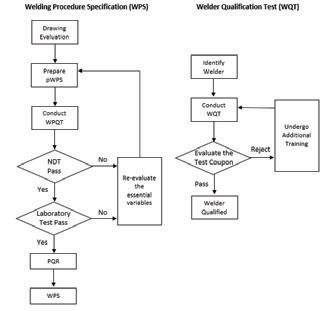

(Historical Flashback & Local Legislation)
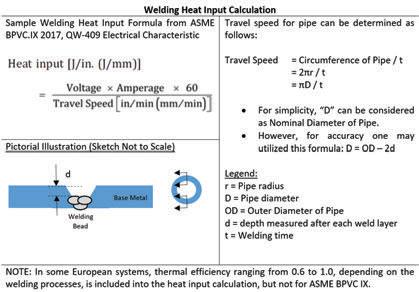
Quality and safety may sound different as well as vary in meaning. Nonetheless, they are closely associated. A quality product will eventually lead to better product safety or, in other words, quality improves safety. It is crucial that companies perform the necessary analysis to balance safety, quality and profit appropriately. This section shares a safety related incident due to poor quality weldment during fabrication (and most likely without a proper WPS in-hand). With respect to the ship that broke into halves, one might wonder if there was any legislation to govern engineering associated industries to prevent such incidents from occurring. Fortunately, in 1994, the Malaysian Parliament approved an Act that addressed this concern. Per OSHA 1994 Section 20, a plant should be safe, without risk to health, when put to use in terms of design and construction, including carrying out the necessary testing and providing adequate information to the users. Moreover, the definition of “Plant” in this Act includes any machinery, equipment, appliance, implement or tool, any component thereof and anything fitted, connected or appurtenant.
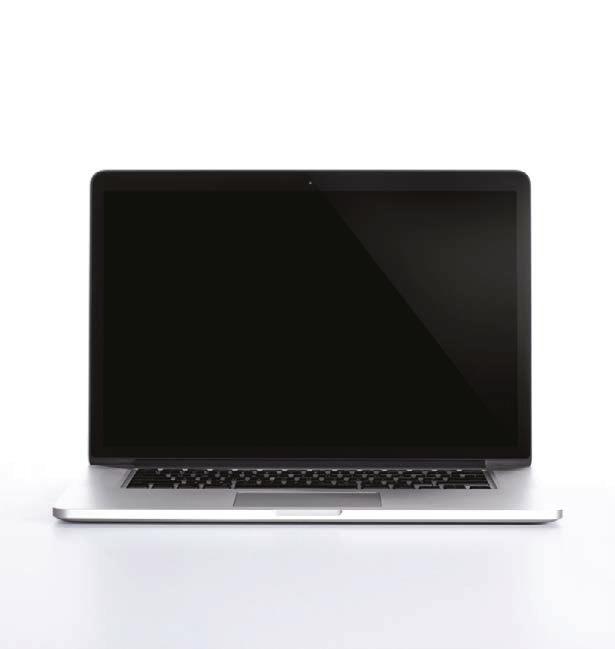
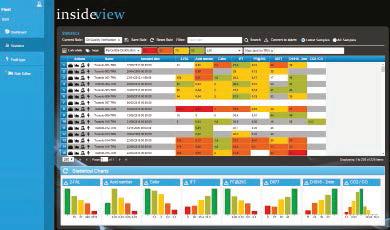
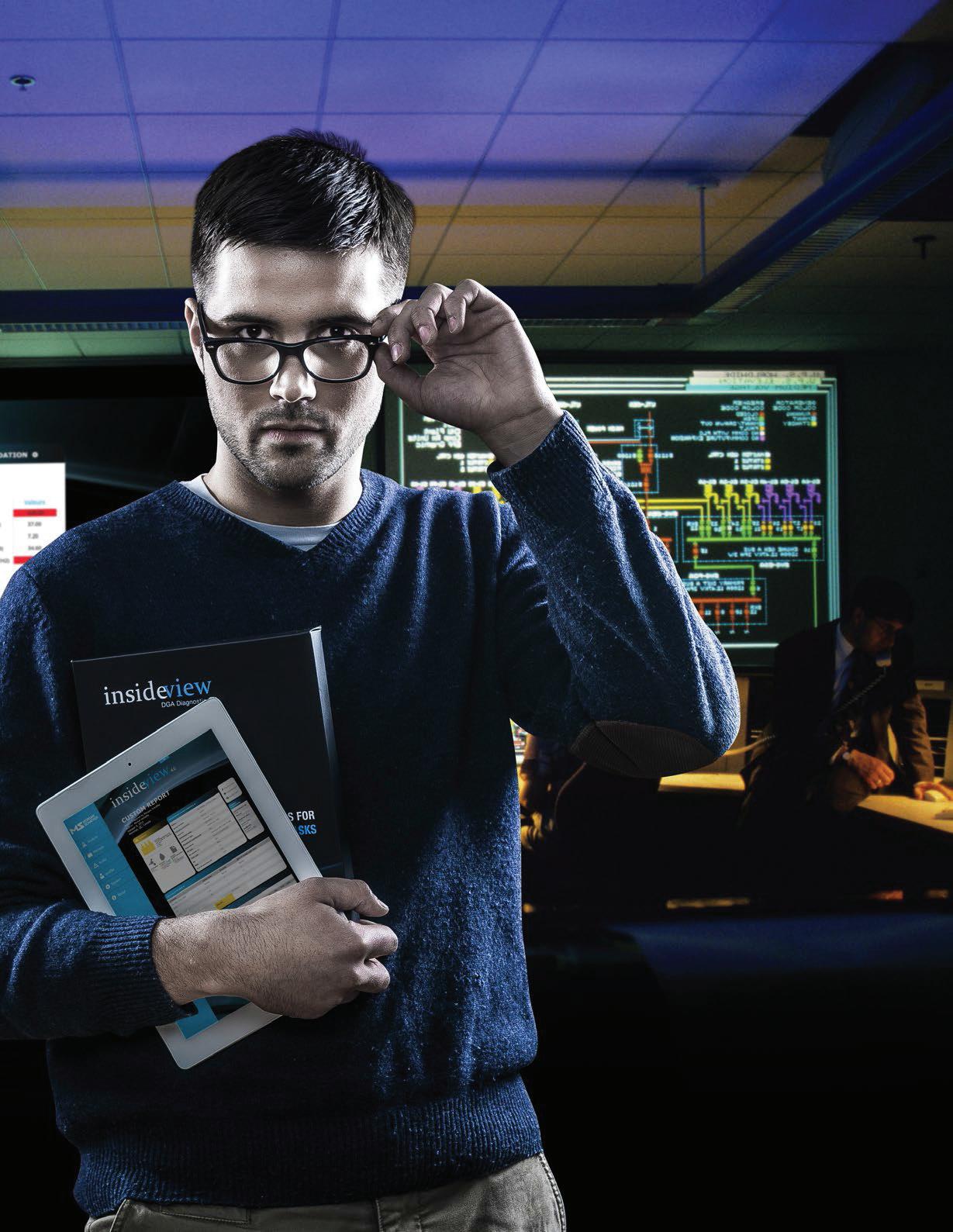






Example of ship that broke into halves
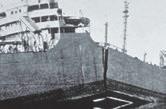
The Liberty ships built during World War II by the Western Allies were produced much faster by using welding than the conventional riveting method. However, some of these ships suffered significant brittle fractures at the hull; in the worst case, a ship broke into 2 parts. Since then, scientists and engineers had put major effort into studying the metal characteristic (e.g. fracture mechanics) and improved the design, including weldment properties, to prevent such occurrences in the future. The root cause was due to Ductile-Brittle Transition Temperature of the specific metals, where the weldment became brittle in relatively cold environments, meaning a lack of Charpy Toughness properties in resisting physical impact prior to fracture.
Section 20. General duties of manufacturers, etc. as regards plant for use at work.
1. It shall be the duty of a person who designs, manufactures, imports or supplies any plant for use at work(a) to ensure, so far as is practicable, that the plant is so designed and constructed as to be safe and without risks to health when properly used (b) to carry out or arrange for the carrying out of such testing and examination as may be necessary for the performance of the duty imposed on him by paragraph (a) and (c) to take such steps as are necessary to secure that there will be available in connection with the use of the plant at work adequate information about the use for which it is designed and-has been tested, and about any condition necessary to ensure that, when put to that use, it will be safe and without risks to health.
Recently there has been a growing interest in 3D printing, notably in metal associated materials. Previously 3D printing was popular but only with thermoplastics products. However, with advancements in science and technology, the material range for 3D printing has expanded, making it more attractive to the engineering industry.
History has taught us that without proper quality control, accidents can occur. The same lesson can be applied to current and future technologies where, prior to actual application, the new products must be thoroughly scrutinised from the aspects of quality and safety. The notion can be like WPS development for 3D printing.
In theory, 3D printing can transform digital 3D software models into 3D solid objects via the additive manufacturing process, meaning the products are made layer by layer, sequentially. This method differs from the conventional subtractive manufacturing process of cutting larger blocks of material to form the final product. There are advantages in 3D printing for metal products such as the relatively short time to produce complex-shaped parts and generating little if any material waste. Nonetheless, there are downsides, including higher production costs due to the equipment and raw material (metal powder) and size of parts limited by the build volume of the machine itself.
Basically, there are three types of 3D printing technology – Sintering (using heat below melting point), Melting (fusing materials at high temperatures) and Stereolithography (a photopolymerisation method). Regardless of the manufacturing technique, it is crucial to ensure that the metal product from 3D printing is fitfor-purpose in terms of material characteristics. This can
be verified through laboratory testing on the 3D printing specimen and data evaluation. For example, stainless steel parts produced through 3D printing can be compared to standard industrial reference (e.g. A240 316) to determine equivalent per design prior to use. This concept has similarities to WPS development as shown below.
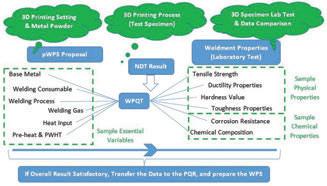
In conclusion, all market products depend on supply and demand, including the element of profit. Though the supplier or fabricator is duly responsible for product safety and quality, it will be advantageous if the end user is aware of the product risk (if this exists) in order to take the necessary mitigation steps. Welded products for critical usage where failure can lead to disaster ought to have an additional quality control barrier established on top of the WPS, such as Batch Sample Destructive Testing, NonDestructive Testing (VI, MPI, DPI, UT, RI), Pressure Test, etc.
Most of these quality safeguards are company initiative per industrial standard but nonetheless some are regulatory requirements. For instance, the Malaysian law on Factories & Machinery (Steam Boiler & Unfired Pressure Vessel) Regulations 1970, Clause 72, calls for a hydrostatic test on this pressurised equipment before it is put into service.
Note:
VI = Visual Inspection; MPI = Magnetic Particle Inspection; DPI = Dye Penetration Inspection; UT = Ultrasonic Inspection; RI = Radiographic Inspection Appendix
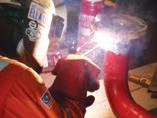
Qualified welder performing welding using Shielded Metal Arc Welding (SMAW) process on a carbon steel pipe-toglange joint connection.
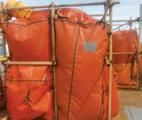
Example of safe habitat being used as a protection in certain high-risk explosion/ fire related facilities during hot work activities such as welding in an offshore oil & gas platform complex.
Fundamentally, the safe habitat extracts air from the safe zone and maintains positive pressure inside the barrier to prevent external potential flammable medium from entering the hot work vicinity, thus creating a safe working environment. As a precaution, extra fixed and portable gas detectors with alert system are normally utilised as additional safeguards to detect ingress of flammable gas inside the safe habitat.
Source: Sample photos taken from Malaysian oil & gas industry
[1] The American Society of Mechanical Engineers, Process Piping (ASME B31.3), 2014
[2] The American Society of Mechanical Engineers, Boiler and Pressure Vessel Code, Section IX (ASME BPVC.IX), 2017
[3] American Petroleum Institute, API Standard 1104, Welding of Pipelines and Related Facilities, 2013
[4] LAWS OF MALAYSIA, ACT 514, Occupational Safety and Health Act 1994.
[5] LAWS OF MALAYSIA ACT 139, Factories and Machinery (Steam Boiler and Unfired Pressure Vessel) Regulations 1970.
[6] www.twi-global.com/media-and-events/press-releases/2015-11-the-50-year-view-offracture (Accessed on 28/Apr/2023)
[7] www.twi-global.com/media-and-events/insights/schenectady-t2-tanker (Accessed on 28/ Apr/2023)
[8] www.twi-global.com/technical-knowledge/faqs/what-is-3d-printing/can-3d-printing-usemetal (Accessed on 30/Jun/2023)
[9] www.twi-global.com/technical-knowledge/faqs/what-is-3d-printing (Accessed on 30/Jun/2023)



The BH Girder is an innovative and enhanced version of PSC Girder that utilizes the Bulb-T shape integrated with Half Slab which enables it to be applied over a span of longer than 60m. By adopting the latest cutting-edge technologies and innovati on, the BH Gir der has been designed to achieve the ultimate goals of “ Cost Effectiveness ”, “ Rapid Construction”, “Aesthetics” and “Safety”.



ciency


● Maximization of prestressing efficiency
● Minimization of prestressing friction loss
● Reduction of substructure cost
● Reduction of slab cost by half slab girder
● Omission of deck slab form work and s hori ng work by half slab girder
● Shorter construction period

● Design computations and analysis
● Construction drawings
● Material and c onstruction specifications
● Cost estimates
● Technical advice and c onstruction assistance
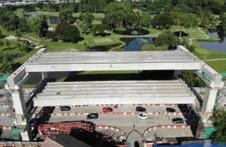


Tel : 012 218 6693( Tan CC)
Tel : 603 6142 6638
Fax : 603 6142 6693
Email : tancc@nehemiah-grp.com Email : enquiry@nehemiah-grp.com




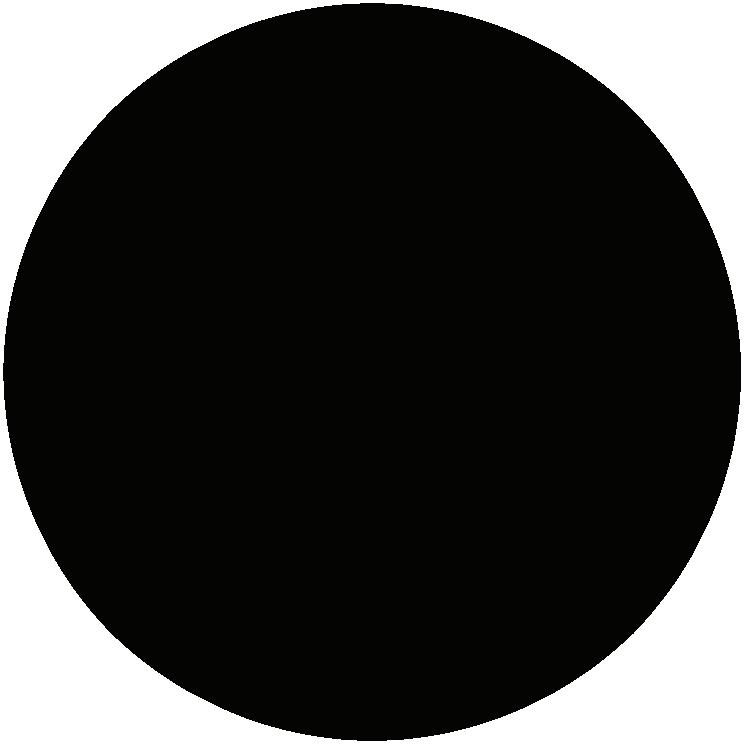






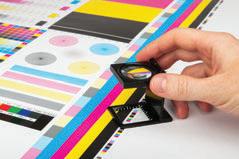
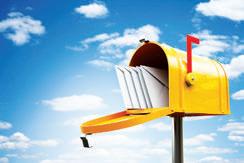
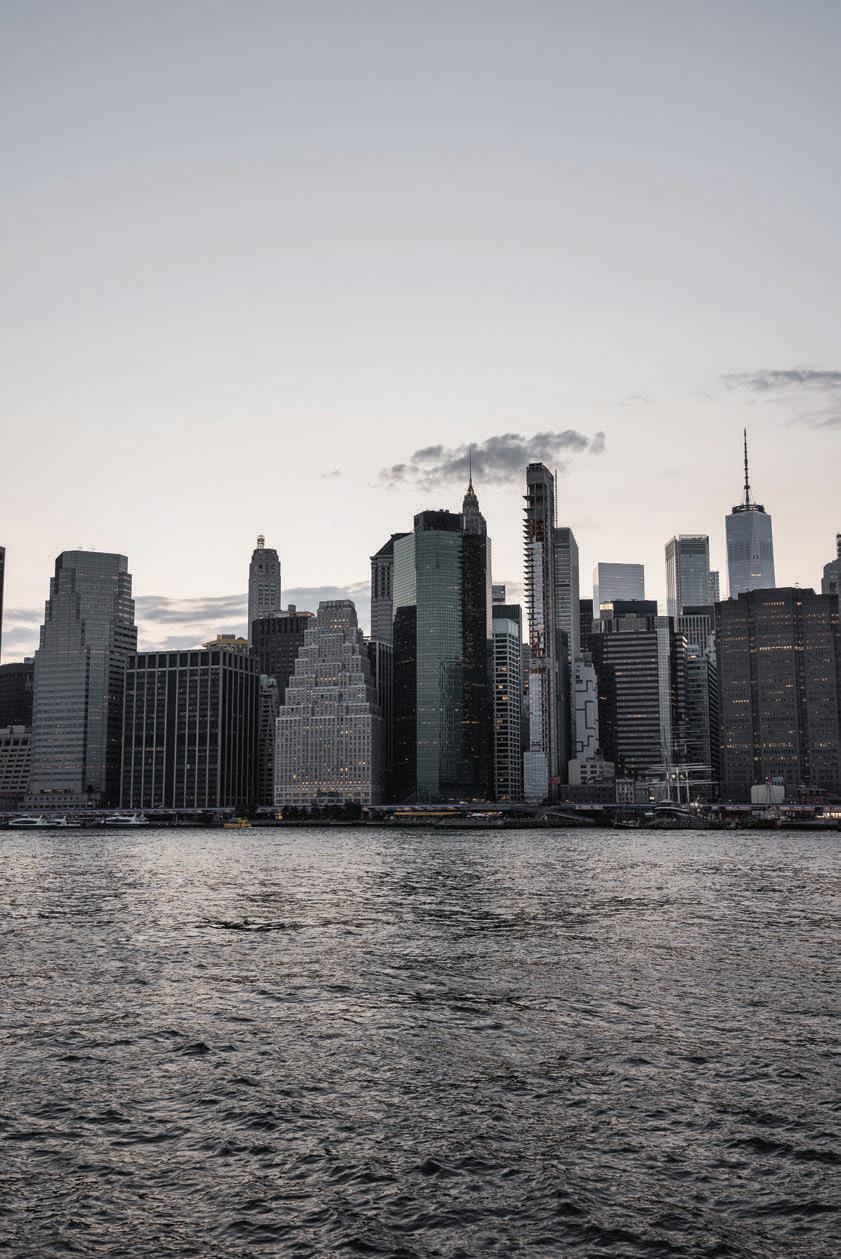
Written and Prepared by:

Equipment, infrastructure and facilities will remain in optimal condition if they are well maintained. But the question is, “what does well-maintained mean?”. Certainly, there are numerous interpretations and perspectives surrounding this term.
In general, well-maintained assets follow a regime implemented within a robust maintenance ecosystem and cultivated as a first-class maintenance culture, rather than being task driven.
In order to instill first-class maintenance culture, the importance of maintenance should be ingrained early on at the asset acquisition stage. The current practice of acquiring assets without forecasting and considering maintenance requirements, particularly cost, needs to be re-visited. A common reason given for such practices is that the intended assets are not listed in the inventory, leading to the oversight.
Thus, to inculcate first-class maintenance culture, the procurement process needs to take into account the life-cycle cost elements of the asset, including in-service maintenance expenses. Otherwise, while the procurement cost may be low, the in-service support budgetary requirement may prove burdensome. In the end, there is a high chance of neglected maintenance resulting in poorly maintained assets.
Maintenance issues often become a topic of interest when incidents of equipment malfunction hamper day-today operations. To prevent this, an efficient and systemic maintenance regime needs to be in place, based on the philosophy that prevention is better than cure. Achieving this aspiration requires formulating and diligently implementing a sound maintenance system.
Practising good maintenance culture in our daily activities is a crucial initial step toward inculcating a firstclass maintenance culture. Displaying maintenance records, such as toilet cleaning logs, hospital facility and elevator inspections, exemplifies this practice. Expanding this culture can lead to best practice that extend to high-valued assets.
Under certain circumstances, it is undeniable that equipment maintenance adopts a “run to failure” approach, where replacement occurs once an item malfunctions. This approach is mainly suitable for non-complex equipment with high spares availability and low parts acquisition cost such as light bulbs and simple digital control circuits. Therefore, the
concept of repair by replacement, coupled with a “just-intime” approach for spare parts, suits such instances.
Besides having a good maintenance regime, sustaining a maintenance culture over the long-term poses another challenge that needs to be properly addressed. Sustainability usually involves policy matters and an enabling implementation environment. As a matter of fact, policies lay out specific directives as well as the methodologies that need to be used while enforcement of maintenance should span across all levels, from leadership to frontline roles. This holistic approach within the maintenance ecosystem will yield high and safe operational availability in the long run.
In certain aspects, a strict maintenance regime may be considered excessive or “over-maintaining”. Alternatively, an alternative philosophy of maintenance, popularly known as “condition-based maintenance” has emerged where maintenance requirement is centred on prediction using monitored and gathered operating parameters data. Even though different in thoughts and ways, these approaches can complement each other, particularly with equipment and parts that are subjected to heat, stress and wear. By combining both methodologies, it acknowledges the potential to achieve optimal maintenance practices, cost-effectiveness and heightened operational availability.
The journey to a first-class maintenance culture is an arduous task for any entity. This culture needs to be inculcated, understood, applied and expanded. Since it is very challenging, awareness, incentive, training, enforcement and application of technology need to be in the maintenance culture ecosystem.
One major conclusion that can be drawn from the maintenance spectrum outlined in this article is that the right maintenance culture must be deeply embedded in our society as the norm and elevated to a top priority by leaders and managers alike.
Such an approach will ensure that assets in any organisation are impeccably maintained, optimising their condition for optimal performance and service delivery to both customers and stakeholders. However, inculcating a first-class maintenance culture is a journey that need to be embarked on at all levels in our daily life through unceasing dedication and passion.
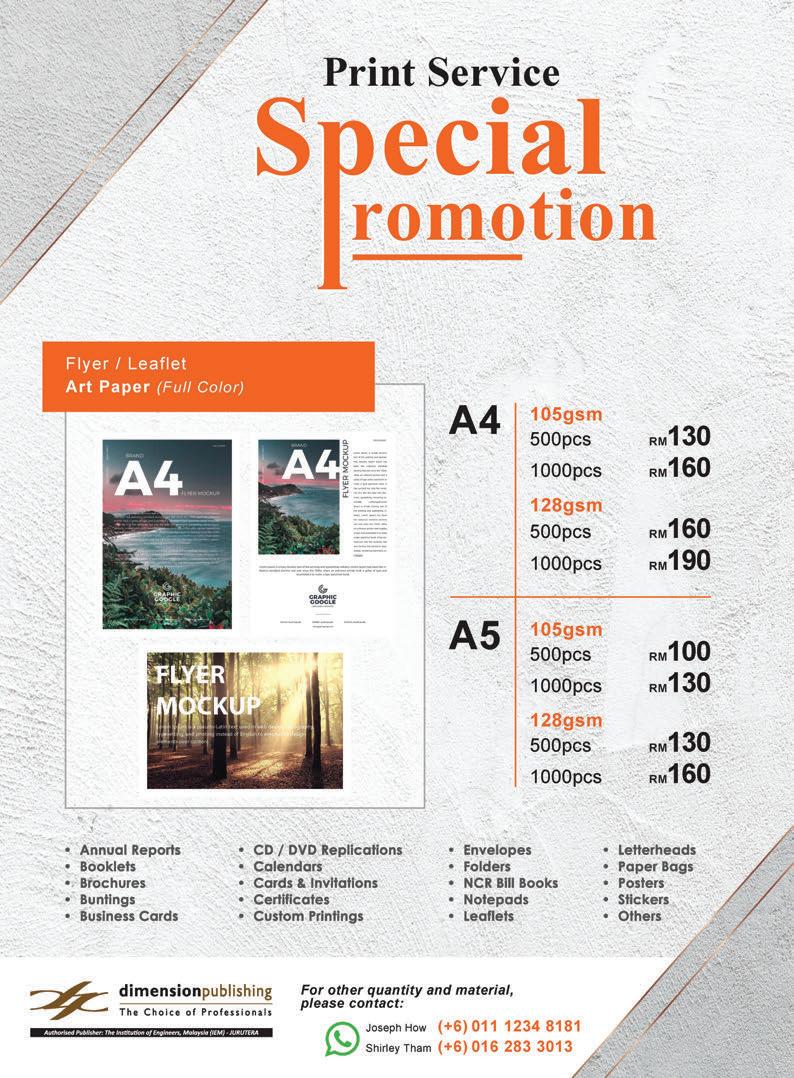
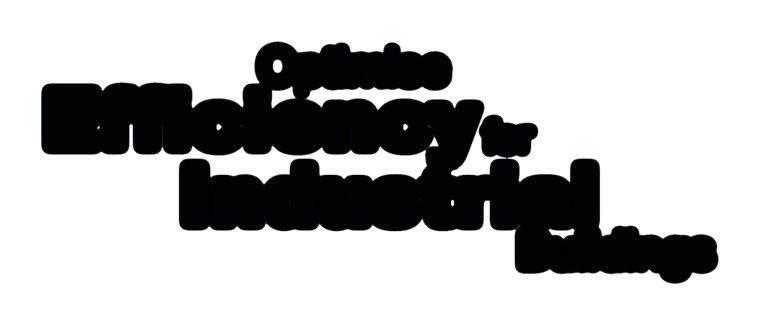
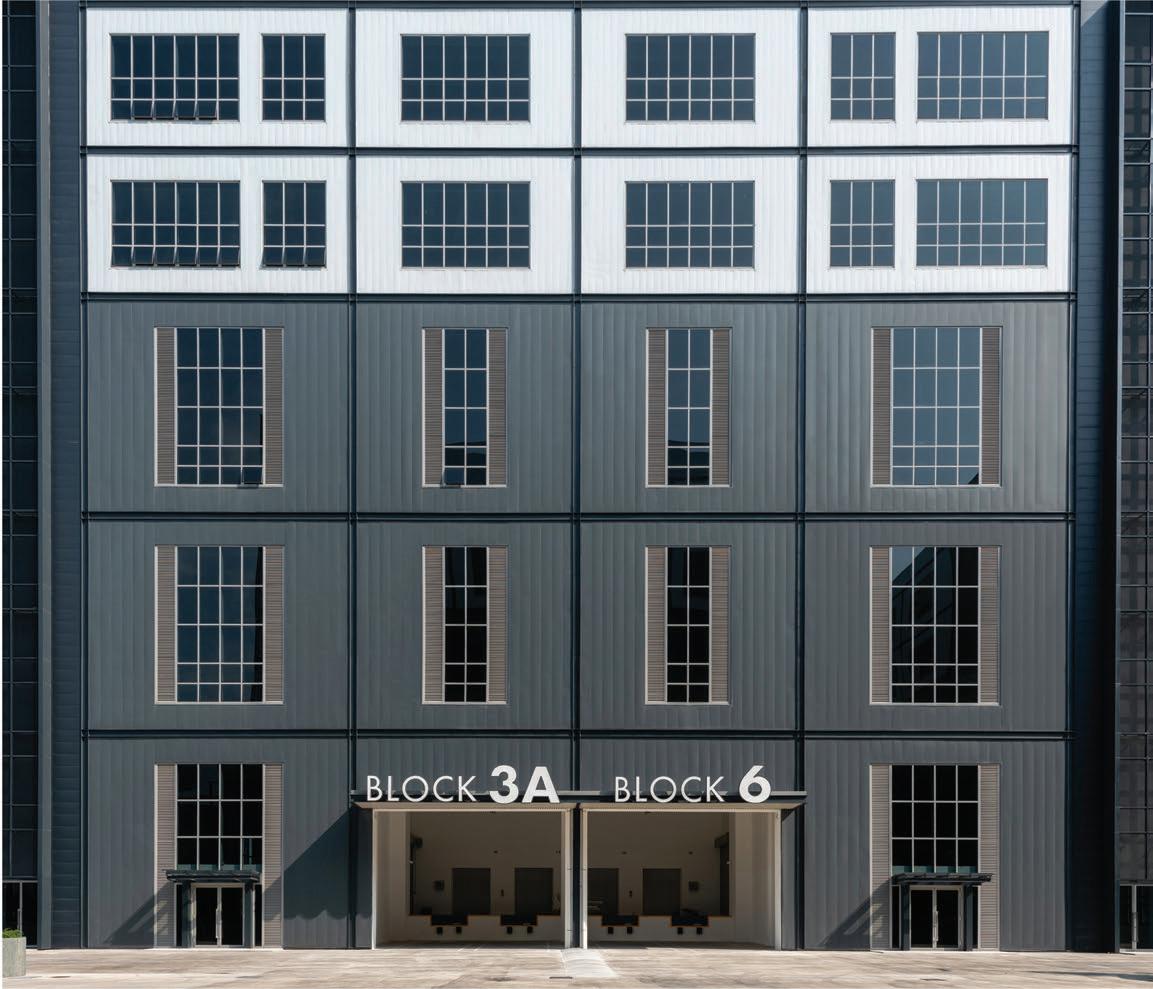

Written and Prepared by:

Our journey into the fascinating world of remotely operated vehicles (ROVs) began with a warm welcome at Subsea Rover (SSR) Sdn. Bhd. facility in Pasir Gudang, Johor, on 23 September 2023. About 20 participants from both industry and government sectors arrived at the facility at 11.00 a.m. on Saturday and were greeted enthusiastically by the SSR team. This set the stage for an exciting half-day of exploration and learning.
Unveiling ROV Technology
The highlight of our visit was an in-depth presentation on ROV technology. The experts at SSR Sdn. Bhd. guided us through the various facets of these remarkable underwater modules and the associated components, providing us with valuable insights into their capabilities and significance.
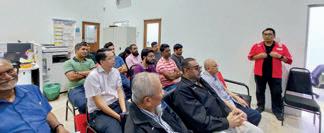
Journey through ROV Technology
It started with an introduction to Subsea Rover (SSR) Sdn. Bhd. The first step into the world of ROVs left us in awe of the technology. Oceans had always posed multiple challenges to explorers as they ventured into the depths of the oceans. The major parameters, such as water pressure, salinity and temperature variations were discussed in length. The complexities of oil and gas exploration were unveiled as we navigated through the challenges that the industry faced. We were shown how ROVs played a pivotal role in overcoming these challenges and helped facilitate critical exploration activities.
Next, we were taken on a journey through the history of ROVs, exploring their evolution and their crucial roles in underwater exploration and intervention. This journey into the past provided context for the innovations we were about to witness. The presentation then shifted to real-world case studies, where we delved into the practical applications of ROVs across various industries. These case studies underscored the significance of ROVs in conducting inspections, maintenance and repair activities. Our minds were blown away by the advanced technologies used in ROVs. We marvelled at the cutting-edge yet practical sensing module, imaging systems, powerful propulsion mechanisms, and robust control and communication capabilities which had enabled these machines to explore the vastness of our oceans.
The design principles governing ROV design and development were revealed in meticulous detail. The importance of hydrodynamics, material selection and structural integrity was emphasised, which helped us appreciate the engineering precision behind these machines. Safety and environmental considerations were
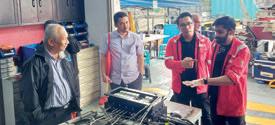
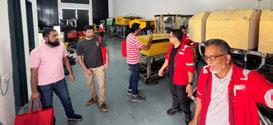
also a core part of the presentation. SSR Sdn. Bhd.’s commitment to responsible practices in ROV operations and its awareness of the environmental impact demonstrated its dedication to sustainability.
Our deep-sea journey concluded with a glimpse into the future of ROV technology. We pondered over the potential of autonomous systems, deeper dives and integration with artificial intelligence, highlighting the ever-evolving nature of this field.
Following the enlightening presentation, a question and answer session allowed participants the opportunity to interact with the SSR team as the former sought clarifications, engaged in discussions and gained deeper insights into ROV technology. This interactive exchange of knowledge and ideas further enriched our understanding of the subject.
Our adventure continued with a guided tour of SSR Sdn. Bhd. Participants had the opportunity to witness the practical aspects of ROV manufacturing and operations up close as it included visits to the SSR warehouse, gantry engineering, SSR Yard 1 and SSR Yard 2. Each stop offered us a unique perspective on ROV production and deployment.
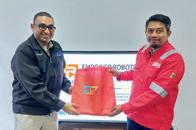
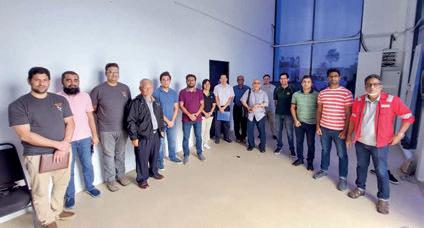
Virtual 2-Day Course on Effective Project Management
Date : 20 - 21 December 2023 (Wednesday - Thursday)
Time : 9.00 a.m. - 5.00 p.m.
Venue : Digital Platform
Approved CPD : 13
Speaker : Ir. Dr Abang Anuar bin Ehsan












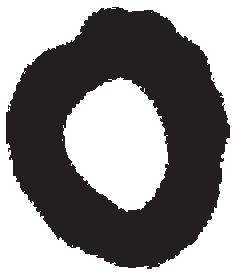
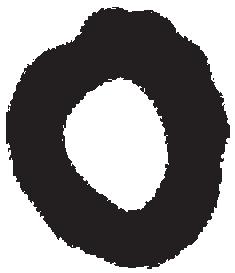


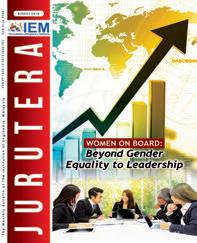

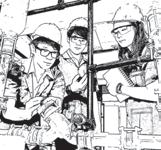





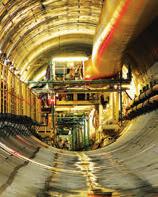
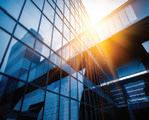
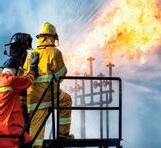

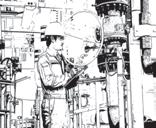
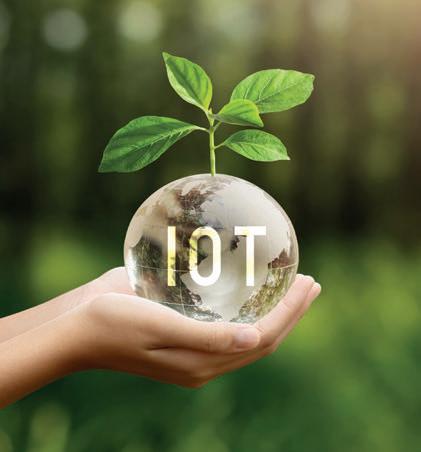






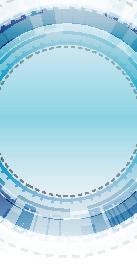
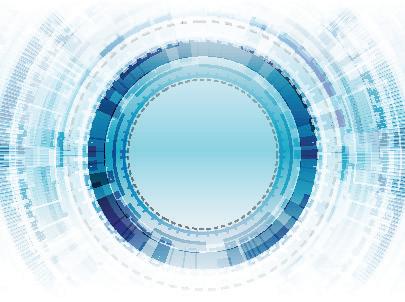



















Written and Prepared by:

The 2023 Sustainable & Integrated Engineering Student Research e-Poster Competition, organised by the Marine Engineering & Naval Architecture Technical Division (MNATD) of The Institution of Engineers, Malaysia (IEM), exemplifies the values of innovation and excellence in the ever-evolving world of engineering and technology. This annual event has consistently nurtured innovative ideas and celebrated excellence among a diverse range of student participants.
Led by MNATD Chairman Ir. Ts. Abdul Malik Hussein bin Abdul Jalil and Chief Judge Ir. Assoc. Prof. Dr Ching Yern Chee, the competition provided a platform for students to present their research findings and gain well-deserved recognition. The dedicated panel of judges, including YBhg. Dato’ Pahlawan Ir. Jasan Ahpandi bin Sulaiman, Ir. Lim Leong Bok, Ir. Assoc. Prof. Dr Ab. Saman bin Abdul Kader, Ir. Teoh Hai Teh and Ir. Roznan bin Abdul Rashid (moderator), ensured fair and rigorous evaluations.
The competition stood out for its celebration of research excellence across a wide spectrum of technical disciplines, from naval architecture to computer science and automation control engineering. It encouraged innovation and cross-disciplinary collaboration and showed that groundbreaking discoveries often occurred at the intersection of different fields.
There were two rounds in the competition and the winners of the first round were honoured on August 19, 2023. The initial phase saw 33 individual participants and 9 group participants, representing an impressive pool of talent. Top individuals and groups advanced to the final presentation round, which was the highlight of the event. Participants had 15 minutes to present their research projects, with a rigorous judging criteria covering clarity, organisation, delivery, time management and the ability to respond to questions.
At the grand finale, which took place in a virtual setting on August 26, 2023, enthusiasts joined the participants on Zoom. Participants were required to be present throughout, underscoring the event’s significance and sense of community.
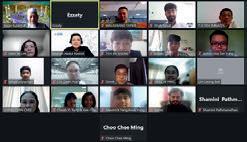
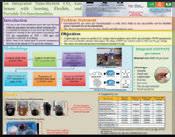
There were outstanding performers in both individual and group categories. The top three individuals were Lim Seen Ye (UCSI), Shah Faizal (APU) and Walisijiang Tayier (Segi). In the group category, the honours went to Cheah Yi Tong & Kee Chai Ying (USM), Kelvin Voo Tze Yung, Sim Chai Ying & Maverick Yang Kouk Yung (Unimas) and Muhammad Fathurizqullah, Adibah Fatihah binti Mohd Yusof, Nursahliza binti Muhamat Yain & Jauhari Khairuddin bin Tahir (UTM). Cheah Yi Tong and Kee Chai Ying also received a special prize for Best Poster Presenter.
In summary, the 2023 Sustainable & Integrated Engineering Student Research e-Poster Competition embodied innovation and excellence in engineering research. It celebrated originality and brilliance across various engineering and technical disciplines, contributing to the advancement of sustainable and integrated engineering practices. Beyond recognising the winners, the competition also inspired innovation and fostered strong bonds among the participants. It stands as a pivotal event in the realm of engineering research and education, inspiring future engineers to reach for the stars. It remains a guiding light for those seeking to push the boundaries of innovation and excellence in engineering and technology.
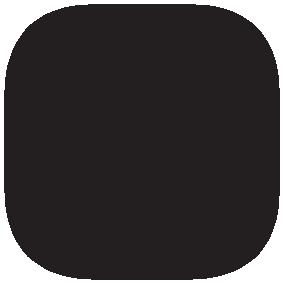
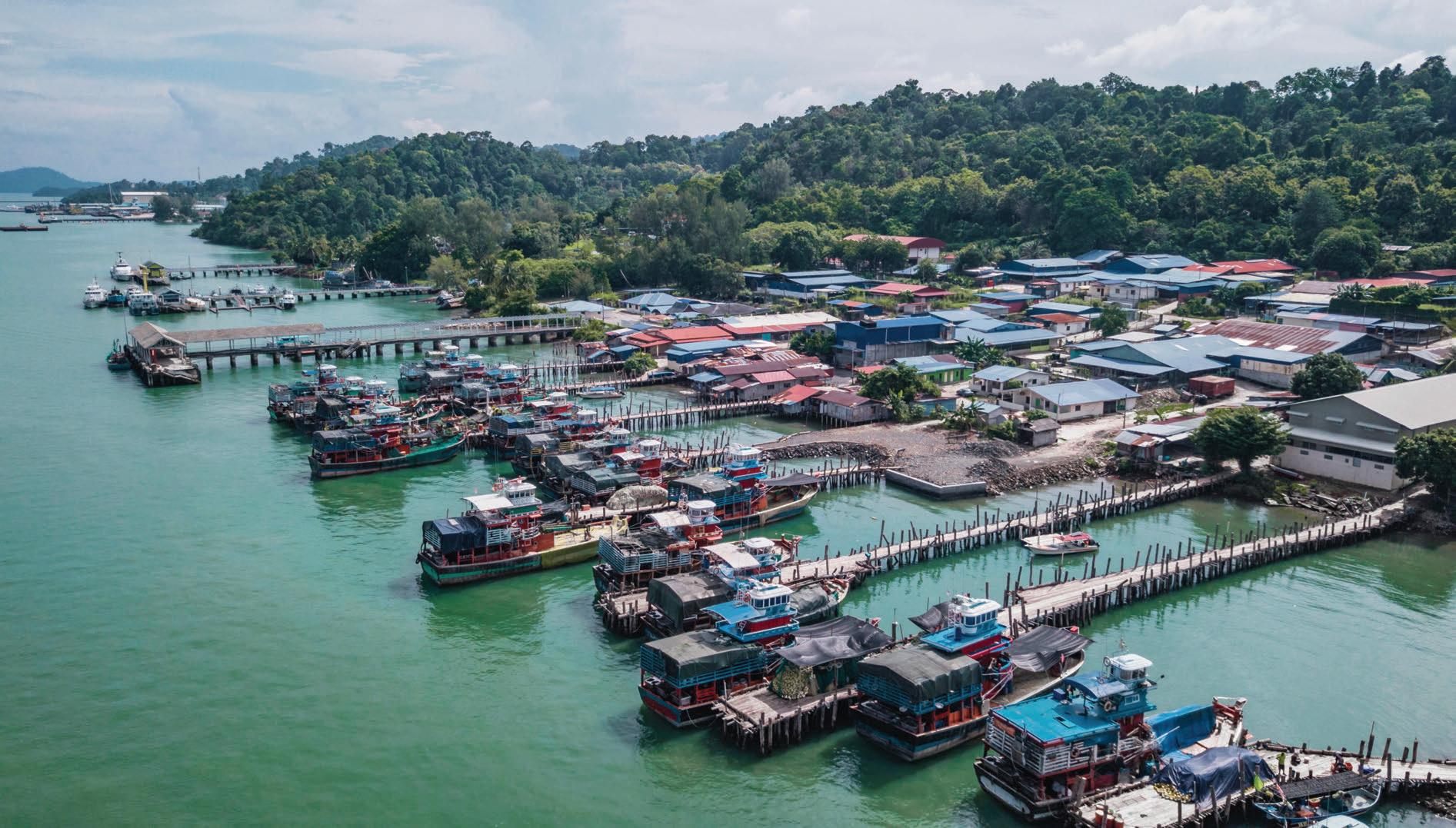
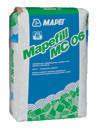
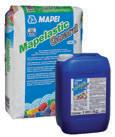

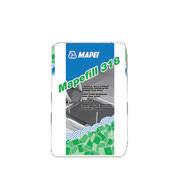


After the AFEO Midterm Governance Board Meeting in Bangkok, I travelled to the Samut Prakan province, 75 minutes outside of central Bangkok, to visit the Ancient City also known as Muang Boran in Thai language.
This open-air park museum in the shape of Thailand has architectural structures, art monuments, replicas and reconstructed historical structures located at the “actual geographical location”, so that visitors can experience exploring the whole country in just 4 hours.
The initial plan was to build a golf course with iconic models showcasing important national sites of Thailand but, as the owners loved art and had a desire to contribute to the community, they changed it to a tourism destination instead. They started to do research with the collaboration of the Thailand National Museum after they noticed that some of the ancient sites had deteriorated as they were not properly maintained.
Visitors to the park can walk around or rent a bike to take part in fun and relaxing activities such
Written and Prepared by:

She works in the Oil & Gas Industry, specialising in Reliability & Asset Management, Instrument & Control and Telecommunication.
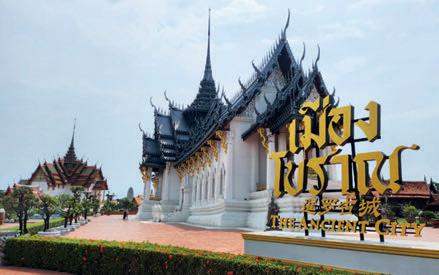
as renting a Thai costume for an Instagram-worthy picture or hop onto a golf cart or tram for a quick tour.
The Ancient City was built according to eras. From 1963 to 1972, the focus was on the early years of Siam history and culture, so replicas of ancient ruins were constructed. These included Dusit Maha Prasat Palace, Sanphet Prasat Palace, and The Footprint of the Lord Buddha.
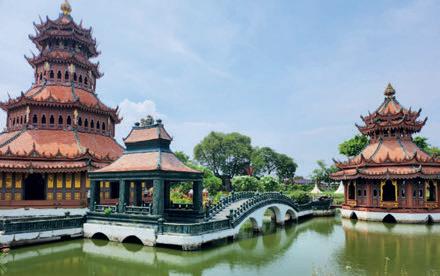
The next phase (1973-1992) showcased the Middle Ages with wooden structures which reflected local community cultural identity, economic trade and the daily lifestyle of the Siamese. Some were built according to original designs and others from dismantled pieces of deteriorated original structures transported to the Ancient City such as The Phra Kaew Pavilion, Northern Thai Village and other Thai houses and floating markets. The Creative Era (1993-2000) had unique structures with their own identity and meaning.
Since the 316-acre park is huge, maintaining and preserving the structures is the hardest part of the museum operations. From 2001 to 2016 the organisation focused on taking care and planning for future sustainability. When both the owners of Ancient City passed away, it was a challenge to maintain their legacy and aspirations.
There are plans to grow and maintain the park as a reference for future education on historical structures and ancient sites of Thailand.
Written
and Prepared by:

Ir. Yasotha Chetty
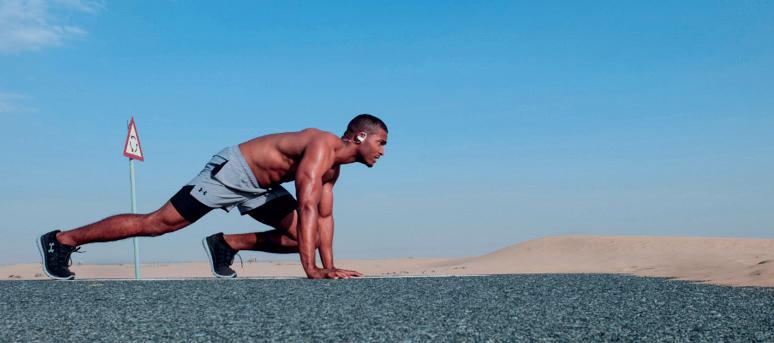
High performance is crucial for consulting engineers as it ensures the delivery of exceptional work, enables the ability to influence the industry, wins projects based on merit and drives positive change within the field.
We achieve and maintain high performance by fostering a spirit of excellence. Excellence should not be confused with perfection. The key distinction lies in the condition of the heart. Here’s what this means:
• Excellence is internally motivated, focused on personal growth. Perfection is externally driven, seeking validation and emphasising performance.
• Excellence appreciates and enjoys the journey; perfection fixates on outcomes and unhealthily strives for them.
• Excellence works towards outstanding results, understanding their value and purpose, while perfection tends to criticise and judge.
• Excellence acknowledges the inevitability of mistakes but remains committed to continuous growth and improvement. Perfection is an intolerance for errors.
John Maxwell, a well-known leadership expert wrote this: “Excellence is the gap between average and exceptional. It’s the ability to exceed expectations and consistently deliver superior quality. In developing habits of excellence, leaders gain influence and stand out from the crowd. By cultivating a culture of excellence, a business attracts customers and wins their loyalty.”
This quote encapsulates well the spirit of excellence. As with anything, it requires aligning our perspectives and attitudes and implementing systems that promote the desired habits.
Engineers often prioritise the technical aspects of their work while neglecting the production of high-quality deliverables. If this applies to you, it’s essential to cultivate a spirit of excellence in this area:
• Understand why high-quality deliverables are crucial and allow the “why” to drive you.
• Familiarise yourself with your firm’s branding styles and established practices.
• Assess the steps necessary to develop your abilities to produce high-quality deliverables.
• Create systems that support your development and the consistent application of this habit.
Paying attention to details is paramount in fostering a spirit of excellence. Develop systems that facilitate the cultivation of this habit.
Continuously learn, grow and hone your technical and non-technical skills. The pursuit of growth, knowledge and skill refinement is a lifelong journey shared among professionals across various fields.
Is it sufficient to aim for 80-20, aim for 80% correctness, accuracy, quality etc.? No, it is not.
Settling for 80% is akin to aiming for the treetops rather than reaching for the stars. It breeds complacency and does not reflect high performance. As humans, we are bound to make errors. Thus, if we acknowledge that errors are inevitable and yet only strive for 80%, the actual outcome will be lower than 80%.
The saying goes: “Aim for the stars and you will land on the treetop.” By aiming for 120%, we get closer to achieving 100%. From the perspective of excellence, 100% is not an unreasonable goal or target. Unfortunately, the world’s pursuit of perfection has tainted the significance of aiming for 100%.
But is 120% attainable? Yes, with a spirit of excellence, it becomes a matter of habit and adopting the right mindset, for instance, understanding the whys and deriving enjoyment from going above and beyond expectations.
An interesting fact: When executing martial arts techniques, practitioners aim beyond the target surface (i.e. 120%, not just 100%). This approach necessitates imagination in martial arts and, in our context, it requires the right perspective and attitude. This technique also applies to how we approach high performance.
The article was first published on www.ohrengineering.com
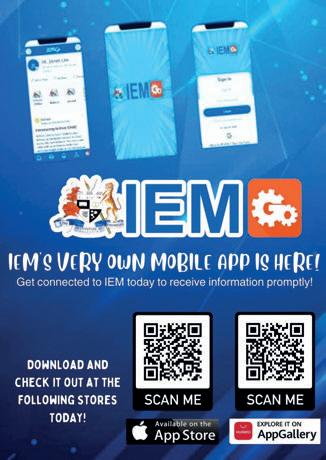











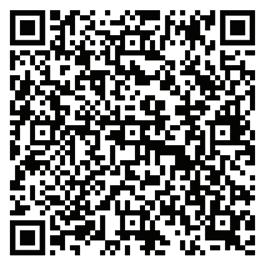
Kepada Semua Ahli,
Tarikh: 21 November 2023
SENARAI CALON-CALON YANG LAYAK MENDUDUKI
TEMUDUGA PROFESIONAL TAHUN 2023
Berikut adalah senarai calon yang layak untuk menduduki Temuduga Profesional bagi tahun 2023.
Mengikut Undang-Undang Kecil IEM, Seksyen 3.8, nama-nama seperti tersenarai berikut diterbitkan sebagai calon-calon yang layak untuk menjadi Ahli Institusi, dengan syarat bahawa mereka lulus Temuduga Profesional tahun 2023.
Sekiranya terdapat Ahli Korporat yang mempunyai bantahan terhadap mana-mana calon yang didapati tidak sesuai untuk menduduki Temuduga Profesional, surat bantahan boleh dikemukakan kepada Setiausaha Kehormat, IEM. Surat bantahan hendaklah dikemukakan sebulan dari tarikh penerbitan dikeluarkan.
Ir. Prof. Dr Zuhaina binti Zakaria Setiausaha Kehormat, IEM
PERMOHONAN BARU
Nama Kelayakan
KEJURUTERAAN AWAM
MOHD FAKHIRIN BIN SAADON BE HONS (UTM) (CIVIL, 2015)
MOHD ZAIDI BIN CHE IDRIS BE HONS (UKM) (CIVIL AND ENVIRONMENTAL, 2007)
SYAIDIE BIN SAFIEE BE HONS (UTHM) (CIVIL (CONSTRUCTION), 2007)
KEJURUTERAAN ELEKTRIKAL
NGU SIE YOONG, ERIC BE HONS (UTP) (ELECTRICAL AND ELECTRONICS, 2018)
KEJURUTERAAN ELEKTRONIK
SUHANA BINTI RASHID BE HONS (UNITEN) (ELECTRICAL POWER, 2005) ME (UNITEN) (ELECTRICAL, 2016)
KEJURUTERAAN PEMBUATAN
SYUKRAN BIN ZAINOL BE (UniMAP) (PRODUCT DESIGN, 2010) ME (UTeM) (MANUFACTURING, 2019)
ZAILANI BIN MUHAMMAD BE HONS (UKM) (MANUFACTURING, 2002) ME (UTeM) (MANUFACTURING, 2015)
KEJURUTERAAN BAHAN
MUHAMAD SHAHIRUL BIN MAT JUSOH BE (UTM) (MECHANICAL, 2004) ME (UTM)(MECHANICAL, 2010) PhD (UTM) (2019)
PERMOHONAN MENJADI AHLI KORPORAT
Nama Kelayakan
KEJURUTERAAN PERTANIAN
LOW CHOON MENG BE (UPM) (AGRICULTURAL, 1998) MSc (UUM) (OCCUPATIONAL SAFETY AND HEALTH MANAGEMENT, 2010)
KEJURUTERAAN KIMIA
YONG WAI FEN BE (UPM) (CHEMICAL, 2006) PhD (NATIONAL UNIVERSITY) (2014)
KEJURUTERAAN AWAM
AKRAM BIN MOHAMAD JAMIL BE HONS (UTM) (CIVIL, 2008) MSc (UTM) (GEOTECHNIQUE, 2013)
ASYRAN BIN SHAMSUDDIN BE HONS (UTM) (CIVIL, 2005)
BIBI SABRENA BINTI SAKANDAR KHAN BE HONS (UTM) (CIVIL, 2004) MSc (UTM) (FACILITIES MANAGEMENT, 2009)
NADZHATUL SYAMIRU USMAIZA BINTI OTHMAN BE HONS (UTM) (CIVIL,2011) MSc (UTM) (STRUCTURES, 2014)
NURUL HAFEEZA BINTI MOHAMED BE HONS (UTM) (CIVIL, 2002) MBA (UTM) (BUSINESS ADMINISTRATION, 2015)
PERPINDAHAN AHLI
No. Ahli Nama Kelayakan
KEJURUTERAAN KIMIA
90376 LEE WUI SIANG, WILSON BE HONS (CURTIN) (CHEMICAL, 2008)
108208 NG TZE SHYAN BE HONS (MONASH) (CHEMICAL, 2017)
58670 RABIATUL AZLIN BINTI MOHAMAD SUPUAN BE HONS (UTM) (CHEMICAL, 2007) MSc (UTM) (PROCESS PLANT MANAGEMENT, 2017)
KEJURUTERAAN AWAM
58885 LIM MING LEEP BE HONS (UTHM) (CIVIL, 2016)
56668 MOHAMED 'AZAM ISAM BIN ISA BE HONS (UTM) (CIVIL, 2011)
65772 MOHAMMAD AIMAN BIN ROSLI BE HONS (UTM) (CIVIL, 2014)
31225 MOHD NOORAFFANDY BIN HARIS BE (UTM) (CIVIL, 2009)
96914 TAN YU ZHE BE HONS (UMP) (CIVIL, 2016)
KEJURUTERAAN ELEKTRIKAL
72447 AMSYAR BIN ALWI BE HONS (UTHM) (ELECTRICAL, 2012)
99367 KHO CHUN JIE BE HONS (NOTTINGHAM) (ELECTRICAL AND ELECTRONIC, 2015) MSc (CURTIN) (ELECTRICAL, 2017)
57021 LIM YANN SIANG BE HONS (UNITEN) (ELECTRICAL AND ELECTRONIC, 2011)
81423 RAMESH A/L VIJAYAN BE HONS (UTAR) (ELECTRONICS AND COMMUNICATIONS, 2013) ME (UNITEN) (ELECTRICAL, 2021)
85271 TARMIZI BIN OMAR RAMIH BE HONS (UTeM) (ELECTRICAL (CONTROL, INSTRUMENTATION & AUTOMATION), 2016)
KEJURUTERAAN ELEKTRONIK
56581 NORHAMIMI BINTI HAMDAN BE (UTM) (ELECTRICAL, 2002) MSc (UTM) (TELECOMMUNICATION AND INFORMATION ENGINEERING, 2014)
KEJURUTERAAN MEKANIKAL
78832 ADAM ALBAKRI BIN HISHAM ALBAKRI BE HONS (UTP) (MECHANICAL, 2019)
87371 FOONG NIX SUN BE HONS (ADELAIDE) (MECHANICAL, 2010)
119912 MOHD HAFEZ BIN AB KARIM BE HONS (UNITEN) (MECHANICAL, 2001)
PERPINDAHAN MENJADI AHLI KORPORAT No. Ahli Nama Kelayakan
KEJURUTERAAN AWAM
79547 CHEAM KOK SENG BE HONS (UTAR) (CIVIL, 2015)
89483 LIEW TZE YEAN BE HONS (KLiUC) (CIVIL, 2010)
58692 MOHD KHAIRUN HAFIZ BIN BAHARUDIN BE HONS (UMP) (CIVIL, 2009)
33218 MOHD RHAZEF BIN CHE SORI BE HONS (UTM) (CIVIL, 2010)
KEJURUTERAAN ELEKTRIKAL
119656 LIM MIN CHONG, DAVID BE (UTM) (ELECTRICAL, 2001)
KEJURUTERAAN BAHAN
54577 YEW MING CHIAN BE (UM) (MATERIALS, 2008) MSc (UM) (MATERIAL, 2011) PhD (UM) (2015)
GUIDELINE FOR PI UNDER MATERIAL ENGINEERING DISCIPLINE
Material Engineering Technical Division (MaTD)
The guideline was endorsed by Council on 16th January 2023.
Material Engineering plays a critical role in shaping the world we live in. Material Engineers are responsible for development, characterization and overall performance of the materials. Given the importance of their work, it is essential that engineers adhere to a set of professional code of conducts to ensure the safety and well being of the public and environment. The engineering fraternity in Malaysia has a long history of establishing and enforcing ethical standards and professional guidelines. The Material Engineering Technical Division (MaTD) has developed an IEM Professional Interview Guideline for Materials Engineers seeking to obtain their Professional Engineering status. These guidelines which is inline with the existing IEM Competency Standard for Professional Interview will provide a framework of integrity, professionalism and accountability for future engineers. The guideline will focus on the general and specialist engineering knowledge and ability for engineers to apply the theoretical knowledge for engineering solutions in Material engineering. The guideline can be request via email to Secretariat at: pi-submission@iem.org.my
CONTINUATION FROM NOVEMBER ISSUE 2023
PERMOHONAN MENJADI AHLI SISWAZAH
No. Ahli Nama Kelayakan
KEJURUTERAAN MEKANIKAL
118944 MOHD RAHIMI AFIF
MOHD RAZALI BE HONS (UNITEN) (MECHANICAL, 2015)
118939 MOHD ABD SHAFIQ
BIN MOHD SA'AD BE HONS (UNITEN) (MECHANICAL, 2019)
118449 AZHARISYAM BIN ABU BAKAR BE HONS (UPNM) (MECHANICAL, 2013)
118995 MOHAMAD SHIRAZI
BIN DAUD BE HONS (UPNM) (MECHANICAL, 2019)
119022 MUHAMAD NAQIUDDIN
BIN RAZAK BE HONS (UPNM) (MECHANICAL, 2020)
119023 WAN NURUL NADIAH BINTI WAN NOR ALAMSHAH BE HONS (UPNM) (MECHANICAL, 2020)
119758 KELVIN CHONG KIAN VOON BE HONS (UTAR SG LONG) (MECHANICAL, 2022)
119755 NG SOO SIEN BE HONS (UTAR SG LONG) (MECHANICAL, 2022)
119754 SOH JIE QI BE HONS (UTAR SG LONG) (MECHANICAL, 2022)
119753 TAN SENG WAH BE HONS (UTAR SG LONG) (MECHANICAL, 2022)
118988 LEE WEI ZHEN BE HONS (UTAR) (MECHANICAL, 2019)
118568 THINESHWARAN A/L SUBRAMANIAM BE HONS (UTM) (MECHANICAL, 2013)
118662 SYED MAHDZAR B. SYED MOHAMED BE HONS (UTM) (MECHANICAL, 2014)
118857 AMIR BIN NORDIN BE HONS (UTM) (MECHANICAL, 2019)
118978 TEOH CHIA YANG BE HONS (UTP)(MECHANICAL, 2014)
118977 NURUL NABILAH HUSNA ZULKIFLEE BE HONS (UTP)(MECHANICAL, 2018)
119029 CHEN ZHI SHEN ME HONS (UNI. OF BRISTOL) (MECHANICAL, 2020)
118961 MUHAMAD AMEER IZZAT BIN KAMARUDIN ME HONS (UNI. OF MANCHESTER) (MECHANICAL, 2021)
119009 PHILIP TAN SHIEN MING ME HONS (UNI. OF NOTTINGHAM)(MECHANICAL, 2016)
118420 Dr CHANG KAI MING ME HONS (UNI. OF SOUTHAMPTON)(MECHANICAL - MECHATRONICS, 2012) MSc (UNI. OF SOUTHAMPTON) (BIONANOTECHNOLOGY, 2014) PhD (UNI. OF SOUTHAMPTON) (ELECTRONIC & ELECTRICAL, 2018)
KEJURUTERAAN PEMBUATAN
119761 CHUWA SHENG YU BE HONS (UTAR SG LONG)(MATERIALS & MANUFACTURING, 2022)
119019 MUHAMMAD RAZIF BIN MAHBOOB ALI BE TECH HONS (UniMAP) (MECHANICAL ENRG. TECH-PRODUCT DEVELOPMENT, 2020) ME (UTeM)(MECHANICAL, 2021)
KEJURUTERAAN PERLOMBONGAN
118661 CHIN CHEAN YEEN BE HONS (USM)(MINERAL RESOURCES, 2008)
KEJURUTERAAN PETROLEUM
118432 SITI AISYAH BINTI SHAMSUL BE HONS (UCSI)(PETROLEUM, 2021)
KEJURUTERAAN POLIMER
118963 MOHAMMAD MUZAKKIR SYAFIQ BIN ABDULLAH BE HONS (USM) (POLYMER, 2017)
PERMOHONAN KEPADA AHLI "ENGINEERING TECHNOLOGIST GRADUATE MEMBER"
No. Ahli Nama Kelayakan
KEJURUTERAAN AWAM
118658 DAYANG NURASHREEN MUNEERA BT AWG MAHMUD B TECH HONS (PUO)(CIVIL, 2017)
118411 CHIN KAI LOON B TECH HONS (UTHM) (CONSTRUCTION, 2020)
KEJURUTERAAN BANGUNAN
118410 JUMATLI BIN ABD HAMID BSc (UTM) (HOUSING, BUILDING & PLANNING, 1999)
KEJURUTERAAN ELEKTRIKAL
118660 SURENTHAR MUNUSAMY B TECH HONS (MSU) (ELECTRICAL & ELECTRONIC, 2021)
KEJURUTERAAN KIMIA
118659 EWIE ASFAHANIE BINTI ABDUL HALIM B TECH HONS (PUO) (CHEMICAL, 2018)
PERMOHONAN KEPADA AHLI "ENGINEERING TECHNICIAN GRADUATE MEMBER"
No. Ahli Nama Kelayakan
KEJURUTERAAN MECHATRONIC
118657 AHMAD HAZIM BIN MOHAMED RIDZUAN DIPLOMA (PUO) (MECHATRONIC,2019)
PERMOHONAN MENJADI AHLI 'INCORPORATED' No. Ahli Nama Kelayakan
KEJURUTERAAN AWAM
118654 TEO GECK HENG BSc (NATIONAL CHENG KUNG UNI.)(CIVIL, 1981)
KEJURUTERAAN KOMPUTER
118655 LEE HAN RICK BSc Hons (APU)(SOFTWARE, 2013)
118409 TAN YU LIONG BSc HONS (STAFFORDSHIRE UNI.)(SOFTWARE, 2013)
KEJURUTERAAN SISTEM MAKLUMAT
118300 KHAMARRUL AZAHARI BIN RAZAK BE HONS (UTM)(GEOMATICS, 2002)
PERMOHONAN MENJADI AHLI 'AFFILIATE' No. Ahli Nama Kelayakan
KEJURUTERAAN ELEKTRIKAL 118653 NURUNNIZA BINTI ZAINAL ABIDIN BSc HONS (UPM) (ENVIRONMENTAL & SAFETY HEALTH, 2002)
KEJURUTERAAN GEOLOGICAL 118408 AISYAH AFIFAH BINTI SELAMAT BSc (UMS)(GEOLOGY, 2013)
KEJURUTERAAN KOMPUTER 118710 BAVANI SUBRAMANIAM BSc HONS (UM)(COMPUTER & COMMUNICATION, 2002)
PERMOHONAN MENJADI AHLI 'ASSOCIATE' No. Ahli Nama Kelayakan
KEJURUTERAAN TELEKOMUNIKASI 118314 AMEIRUL BIN ABD KARIM DIPL. TECH. (MMC) (TELECOMMUNICATION, 2014)
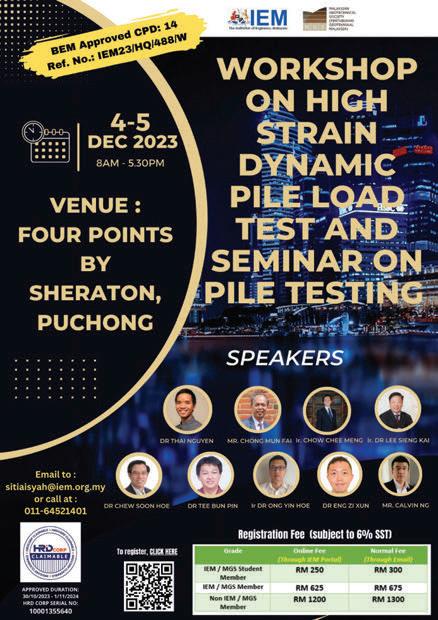
Persidangan Majlis IEM yang ke-434 pada 16 Januari 2023 telah meluluskan sebanyak 1,936 ahli untuk permohonan baru dan permindahan ahli. Berikut adalah senarai ahli mengikut disiplin kejuruteraan:
Senarai nama ahli dan kelayakan adalah seperti di bawah. Institusi mengucapkan tahniah kepada ahli yang telah berjaya.
Ir. Prof. Dr Zuhaina binti Zakaria
Setiausaha Kehormat, Institusi Jurutera Malaysia, Sesi 2022/2023
PERMINDAHAN AHLI KEPADA AHLI FELLOW
No. Ahli Nama Kelayakan
KEJURUTERAAN AWAM
17503 Ir. CHANG TOONG WHO BE. HONS (UTM) (CIVIL) (2000)
18782 Ir. CHONG CHEE YEN BE. HONS (UTM) (CIVIL) (2001) MSc (UPM) (2003)
PEMINDAHAN KEPADA AHLI 'SENIOR' No. Ahli Nama Kelayakan
KEJURUTERAAN AWAM
54501 SREERAMALU A/L NAMATHEVAN BE HONS (UTM)(CIVIL, 2005)
PEMINDAHAN AHLI KEPADA AHLI KORPORAT No. Ahli Nama Kelayakan
KEJURUTERAAN AUTOMOTIF
49372 RIFQI IRZUAN BIN ABDUL JALAL BE HONS (OKAYAMA) (MECHANICAL, 2008) PhD (LOUGHBOROUGH) (2018)
KEJURUTERAAN AWAM
36869 AZRI BIN SAFLIE BE HONS (UKM) (CIVIL & STRUCTURAL, 2002)
21189 CHAN YORK LIN BE HONS (UTM) (CIVIL, 2003)
54085 CHEONG WAI KEONG BE HONS (UNIMAS) (CIVIL, 2010)
93542 CHIA YING SIM ME HONS (LEEDS) (CIVIL & STRUCTURAL, 2011)
61932 CHUA CHIEN MING BE HONS (KINGSTON) (CIVIL, 2011) MSc (SURREY) (STRUCTURAL, 2013)
97437 CHUA PENG YANG BE (UMP) (CIVIL, 2013)
101993 LAU CZE HIENG, BRYAN BE HONS (CURTIN) (CIVIL & CONSTRUCTION, 2016)
99525 LAU HUI HIE BE HONS (UTM) 9CIVIL, 2012) ME (UTM) (CIVIL-STRUCTURE, 2013)
69784 LEONG GEOK TENG BE HONS (UNIMAS) (CIVIL, 2017) ME (UNIMAS) (2019)
23201 LIM CHEE SENG BE HONS (NANYANG) (CIVIL, 1999) MSc (NANYANG) (INTERNATIONAL CONSTRUCTION MANAGEMENT, 2004)
114770 LIM JIA YIN BSc HONS (NATIONAL TAIWAN UNIVERSITY) (CIVIL, 2013)
37095 MOHD HAZRUL FAEZ BIN RAHIAM BE HONS (UTHM) (CIVIL, 2011)
53605 MUHAMMAD AKRAM BIN AMIRUDDIN BE HONS (UKM) (CIVIL & STRUCTURAL, 2013)
35621 MUHAMMAD ALI FATHULLAH BIN ABDULLAH BE HONS (UiTM) (CIVIL, 2005)
54418 MUHAMMAD QAYYUM BIN AMRAN BE HONS (UiTM) (CIVIL (INFRASTRUCTURE), 2014)
85499 QUAH KEN YONG BE HONS (UTHM) (CIVIL, 2011)
105239 ROSLEE BIN ISMAIL BE HONS (UNISEL) (CIVIL, 2009)
112826 STRIPRABU A/L STRIMARI BE HONS (UNIMAS) (CIVIL, 2012) PhD (UNIMAS) (2018)
116024 TAN JIA XIANG BE HONS (CURTIN) (CIVIL & CONSTRUCTION, 2012)
57624 TAN ZHI HOWE BE HONS (UTM) (CIVIL, 2013) MSc (NANYANG) (CIVIL, 2021)
45224 WIRA AZIZI BIN KADER BE HONS (UTP) (CIVIL, 2011)
37252 WONG BAK SHIIUN BE HONS (UTP) (CIVIL, 2008)
41754 WONG PU YING BE HONS (UKM) (CIVIL & STRUCTURE, 2012)
52568 YEW PHAIK KHUAN, LINDA BE HONS (UTM) (CIVIL, 2010)
HONS (USM) (ELECTRICAL, 2010) ME (MALAYA) (POWER SYSTEM, 2015)
52904 ARNOLD VIC CHANDLER JUILY BE HONS (USM) (ELECTRICAL & ELECTRONICS, 2014) 48635 GANESH DEVAN A/L SUBRAMANIAM BE HONS (UTHM) (ELECTRICAL, 2013)
Note: Continuation would be published in January 2024. For the list of approved “ADMISSION TO THE GRADE OF STUDENT”, please refer to IEM web portal at http://www.myiem.org.my.
SENARAI PENDERMA KEPADA WISMA DANA BANGUNAN IEM
Institusi mengucapkan terima kasih kepada semua yang telah memberikan sumbangan kepada tabung Bangunan Wisma IEM. Ahli-ahli IEM dan pembaca yang ingin memberikan sumbangan boleh berbuat demikian dengan memuat turun borang di laman web IEM http:// www.myiem.org.my atau menghubungi secretariat di +603-7968 4001 / 5518 untuk maklumat lanjut. Senarai penyumbang untuk bulan Oktober 2023 adalah seperti jadual di bawah: NO. NO. AHLI NAMA
1 102460 MR. MOHD HASSAN BIN AHMAD 2 38756 MS. WAFTY BINTI ABD RAHMAN
3 12374 MR. DZULAIDIN TASRIN BIN OTHMAN 4 116119 MR. PETDRAL CARLOS ANAK RINGIN
5 21570 Ir. DR GOVINDARAJAN S/O VEERAPPAN
6 90740 MR. KUEK CHAI JIAN Pengumuman yang ke-181
Yes! I would like to be a subscriber of The Institution of Engineers, Malaysia’s publications
Name: _________________________________________________________________________________________________________
Mailing Address: _________________________________________________________________________________________________
Company/Institution: ______________________________________________________________________________________________
Telephone
New Subscriber Renewal
Please commence my subscription from: _________________________(month/year) Signature: _______________________________
To start your subscription of IEM’s publications, complete this form and mail it back to the address below. For faster processing, fax it to: +603 7493 1047. Thank you.
What is your primary job title?
Corporate Management (including chairman, president, proprietor, partner, director, vice president, general manager, division manager, import/export manager, other corporate title)
Management (including project/contract/equipment/service/transport district manager, clerk of works, other technical or operating manager)
Engineering/Design (including chief engineer, chief designer, civil/ highway/mechanical/planning engineer, other engineering/design title)
Buying/Purchasing (including chief buyer, buyer, purchasing other buying/purchasing title)
Titles allied to the (architect, consultant, surveyor, research and development professor, lecturer, supervisor, superintendent, inspector or other allied title)
Others (please specify) ____________________________
What type of organisation do you work in? (Tick one box only)
Contractor
Sub-contractor specialist
Design and build contractor
Consulting engineering/architectural/quantity surveying practice
Mining/quarrying/aggregate production company
Petroleum producer
International/national authorities
National/regional/local government
Public utilities (electricity, gas, water, deck and harbour, other)
Manufacturer
Distributor/importer/agent
Construction department of large industrial/Commercial concern
Association/education establishment/research
Construction equipment hire/rental company
Project/construction management consultancy
Others (please specify) _______________________________
What are the main activities of your organisation? (Tick all that apply)
Constructions of: Manufacturer of:
Roads/bridges
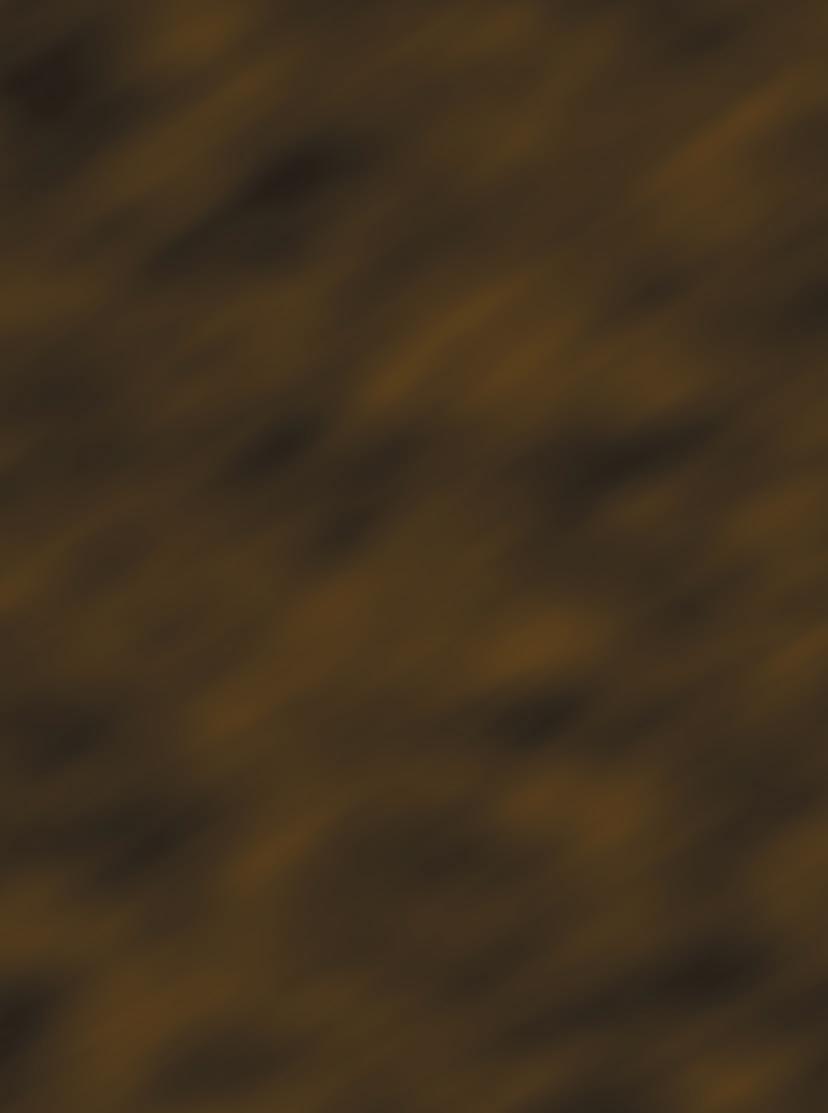
Construction equipment
Dams/reservoirs/irrigation Cement structures Other construction materials
Foundations/tunnels
Structures/steel work
Distribution
Construction equipment
Construction materials
Building (commercial, industrial) Hire/rental of construction equipment
Housing Design
Construction management Earth-moving/open cast mining
Deep mining Aggregate production
Others (Please specify) _________________________________________
Rate (Please tick)
RM360.00 - 12 issues of JURUTERA
RM84.00 - 2 issues IEM Journal (Half-yearly)
Terms and Conditions:
1) The subscription is to be prepaid.
2) Please make cheque payable to Dimension Publishing Sdn. Bhd.
3) Subscriptions are not refundable.
4) Magazine/s will be sent to the mailing address given.
5) Students are entitled for a 20% discount from the above subscription rate.
6) Students must submit a photocopy of the student card together with the payment.
7) The above rate is inclusive of delivery charges and applicable in Malaysia only.
8) Additional delivery charges will apply to overseas subscribers.
For subscription enquiries, please contact +603-7493 1049 or email to info@dimensionpublishing.com
